






EVENTS RAISE MORE THAN $300K FOR CONSERVATION NONPROFITS
DIERKS BENTLEY, MAREN MORRIS AMONG MEMORABLE ACTS
EARLY LOOK AT POTENTIAL COLD SMOKE HOUSING DEVELOPMENT
REMEMBERING BIG SKY’S PARODY ARTIST, TERRY STEBBINS
STAYING PREPARED FOR WILDFIRE
BIG SKY’S LAUNDRY DESERT

August 8 - August 21, 2024 Volume 15, Issue No. 16
Owned and published in Big Sky, Montana
PUBLISHER
Eric Ladd | eric@theoutlawpartners.com
EDITORIAL
VP MEDIA
Mira Brody | mira@theoutlawpartners.com
ASSOCIATE EDITOR
Jack Reaney | jack@theoutlawpartners.com
DIGITAL PRODUCER
Jen Clancey | jen@theoutlawpartners.com
EDITORIAL CONSULTANT
Leslie Kilgore | leslie@theoutlawpartners.com
EDITORIAL INTERN
Fischer Genau | frgenau@gmail.com
LEAD GRAPHIC DESIGNER
ME BROWN | maryelizabeth@theoutlawpartners.com
CHIEF OPERATING OFFICER
Josh Timon | josh@theoutlawpartners.com
CHIEF MARKETING OFFICER
Megan Paulson | megan@theoutlawpartners.com
VP DESIGN & PRODUCTION
Hiller Higman | hiller@theoutlawpartners.com
DIRECTOR OF RELATIONSHIPS
Ersin Ozer | ersin@theoutlawpartners.com
MARKETING MANAGER
Tucker Harris | tucker@theoutlawpartners.com
CONTENT MARKETING LEAD
Taylor Owens | taylor@theoutlawpartners.com
SENIOR ACCOUNTANT
Sara Sipe | sara@theoutlawpartners.com
BUSINESS DEVELOPMENT LEAD
Patrick Mahoney | patrick@theoutlawpartners.com
Will Brennecke, Kaley Burns, Nolan Eastman, Peter Gartrell, Rachel Hergett, Andy Nagel, George Ortiz, Benjamin Alva Polley, Laura Wells, Robb Wolf.

On Friday, Aug. 2, the Big Sky Community Organization opened a new playground at the Big Sky Community Park. According to BSCO, the playground is designed to entertain three different age groups, which means there’s something for every level of adventurer. PHOTO BY JACK REANEY
REMEMBERING BIG SKY’S PARODY ARTIST, TERRY STEBBINS
Terry Stebbins was one-of-a-kind. A Big Sky resident in the early 2000s, he wrote more than five dozen parodies of popular songs, his lyrics telling real stories about Big Sky. Also a dedicated father and husband, he fought fearlessly for six years after being diagnosed with nearly stage-four colon cancer. He showed deep love to his wife, two children and even strangers, and his final years were full of surfing and skiing.
BIG SKY’S LAUNDRY DESERT
14 10 11 13 17 20
Country music singer and Oklahoma-native Wyatt Flores has quickly risen in the charts this summer as he completes his U.S tour. Flores played at Wildlands Festival on Aug. 3, opening for Dierks Bentley. PHOTO BY LAURA WELLS
EDITORIAL POLICY
Outlaw Partners, LLC is the sole owner of Explore Big Sky. EBS reserves the right to edit all submitted material. Printed material reflects the opinion of the author and is not necessarily the opinion of Outlaw Partners or its editors. EBS will not publish anything discriminatory or in bad taste.
EBS welcomes obituaries written by family members or from funeral homes. To place an obituary, please submit 500 words or less to media@theoutlawpartners.com.

Big Sky might have a lot of resources, but since 2022, a laundromat has not been on the list. Aside from a single washer and dryer available at the local food bank resource center, residents without machinery at home might need to drive an hour for clean clothes.
STAYING PREPARED FOR WILDFIRE
With fire danger high from a hot, dry July, EBS spoke with Dustin Tetrault, new fire chief for the Big Sky Fire Department, about preventing fire events and staying prepared for those beyond our control. The Fire Adapted Big Sky Wildfire Hub, a website, is a central location where the Big Sky community can stay up-to-date on current fire danger and air quality conditions, among other useful information. Tetrault also highly recommends signing up for the Gallatin County Emergency Notification System.
EARLY LOOK AT POTENTIAL COLD SMOKE HOUSING DEVELOPMENT
A planned Big Sky housing development, known as Cold Smoke, would include 264 apartments and 125 single-family homes, all deedrestricted and exclusive to local workers. Cold Smoke is being planned by Lone Mountain Land Company and the nonprofit Big Sky Community Housing Trust. Single-family homes would be available for rent and for purchase, including deed-restrictions and mechanisms to preserve the permanent affordability of for-sale units.
HUCKERS WIN SOFTBALL TOURNAMENT
The Hillbilly Huckers overcame the loser’s bracket on Sunday, Aug. 4, winning back-to-back championship games to earn the 2024 tournament trophy in the Big Sky Softball League. BSCO will keep the softball energy alive after this year’s early tournament, hosting pickup softball games throughout September.
WILDLANDS FESTIVAL: A NIGHT OF CONSERVATION, WORLD-CLASS MUSIC
Across three nights, the 2024 Wildlands Festival raised $303,000 for Montana conservation nonprofits Gallatin Valley Land Trust, Wild Montana and the Greater Yellowstone Coalition. Wildlands performers included Maren Morris, Wyatt Flores and Lukas Nelson, and on Saturday night, country star Dierks Bentley gave the crowd an encore to remember.
LETTERS TO THE EDITOR
Letters to the editor allow EBS readers to express views and share how they would like to effect change. These are not Thank You notes. Letters should be 250 words or less, respectful, ethical, accurate, and proofread for grammar and content. We reserve the right to edit letters and will not publish individual grievances about specific businesses or letters that are abusive, malicious or potentially libelous. Include: full name, address, phone number and title. Submit to media@outlaw.partners.

ADVERTISING DEADLINE
For the August 22nd issue August 14th, 2024
CORRECTIONS
Please report errors to media@outlaw.partners.
OUTLAW PARTNERS & EXPLORE BIG SKY P.O. Box 160250, Big Sky, MT 59716 (406) 995-2055 • media@theoutlawpartners.com © 2024 Explore Big Sky unauthorized reproduction prohibited


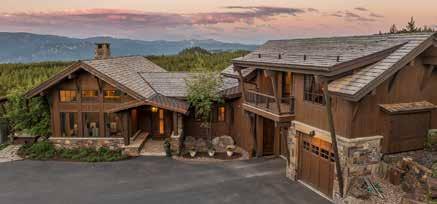



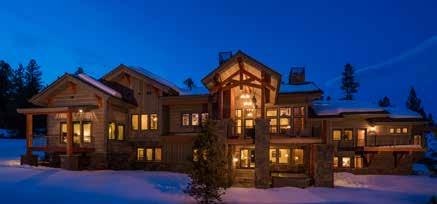
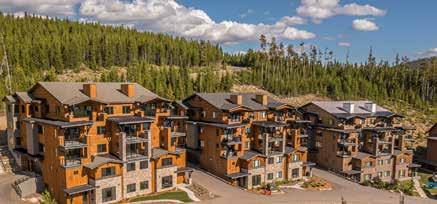



EBS STAFF
Firefighters responded to the Fox Creek Fire on the afternoon of Aug. 2. The Fox Creek Fire is burning in the South Cottonwood drainage near Hyalite Canyon and measured at 3.5 acres as of Aug. 3. The fire is determined to be caused by lightning.
On Friday, shortly after the fire was identified, four smokejumpers and one type 3 helicopter were deployed to the Hyalite area. By Saturday, a type 3 helicopter, a type 2 helicopter, and a type 1 helicopter had been using Hyalite Reservoir extensively to fill buckets and drop water on the fire. Nineteen smokejumpers were also on site by Sunday, according to a Facebook post by the Custer Gallatin National Forest. Although there are no closures at this time, fire managers are requesting that the public give helicopters room to work.
Often busy during fair-weather weekends, Hyalite visitors were quick to share footage of crews at work, such as Reddit user “mchmnd” who shared a clip of a type 1 helicopter pulling water from the reservoir on Aug. 3, or Carla Knoll who shared a clip of two smokejumpers in action on Facebook’s Bozeman Hiking Forum.
The Fox Creek Fire is currently 0% contained and burning timber.
“With the steep terrain and proximity of the South Cottonwood drainage to the Hyalite area, fire managers implemented a timely suppression response in the initial attack of the fire, using smokejumpers on Aug. 2 through Aug. 4 along with helicopters assisting the firefighters by dipping out of hyalite reservoir as a water source and dropping buckets of water to cool down hot spots,” stated the national forest’s Facebook post. “Forest Service firefighters and managers made decisions based on risk assessments to safely deploy firefighting resources to suppress the fire.”
BIG SKY SOUL SHINE
Big Sky Soul Shine is a community-centered fundraiser for amyotrophic lateral sclerosis ALS, a fatal disease that attacks the nervous system and progressively degenerates muscle movement and breathing. While the disease is focused on taking away, Big Sky Soul Shine counters by giving back. In its first year as an official nonprofit, the country fair event raised more than $22,000. Half of these funds will be donated to Team Gleason, an organization founded by Steve Gleason, a former NFL player with ALS. While there is no cure for ALS, Team Gleason focuses on providing resources to those impacted by the disease so they can continue to live purposeful lives. The remaining funds will be donated directly to Shaw. Big Sky Soul Shine continues to accept donations on its website, and all additional contributions made in 2024 will also be split evenly between Shaw and Team Gleason.
Big Sky Soul Shine started in 2017 when The Hungry Moose Market & Deli’s co-founders, Mark and Jackie Robin, used their traditional sponsorship of the summer’s first Music in the Mountains to express gratitude to the community following Mark’s ALS diagnosis. Mark passed away from the disease later that year, and Soul Shine lived on as a way to keep his memory alive and raise funds for those living with ALS.
“Big Sky Soul Shine offers a day of enormous fun and community connection while also educating participants about the heart wrenching effects of ALS,” said Jackie Robin, Big Sky Soul Shine founder. “Defeat ALS is the ultimate message. Wrapping our arms around those living with the disease and their loving caregivers is the real reason Big Sky Soul Shine exists.”
The event raised impressive funds through the pickleball tournament and carnival thanks to many generous local sponsors, which were topped off by an outpouring of additional generous donations. Now as a nonprofit, Big Sky Soul Shine can continue its impactful work throughout the year in addition to throwing one of Big Sky’s most beloved events of the summer.
PUBLIC NOTICE IS HEREBY GIVEN
that as of July 31, Phillip Dillavou, dba Family Meal by Phil, has, as a second delinquent offense within a 12-month period, failed to remit Resort Tax to the Big Sky Resort Area District (BSRAD) for 90+ days.






I’ve seen Gibson Guitars music flyers around town, where can the community find out more about all the live music happening in Big Sky?
LMLC is proud to announce the launch of a comprehensive, community-wide music calendar featuring all the venues in Big Sky that host artists and musical performances. This initiative brings together a vibrant network of local venues, including Tips Up, The Montage, Big Sky Resort, Big Sky Arts Council, WMPAC, The River House, The Waypoint, and many others. It has been exciting and rewarding to bring these hosts together around a single project that enhances access to live music and benefits the overall community of Big Sky.
We aim to have this one-stop site serve locals and visitors, further energize our community, and inspire our local Artist community. Another goal is to engage concierge teams and property managers to include this in pre-arrival information so guests can plan their trips not just around their outdoor pursuits but also all music and nightlife.
This venture marks a first-of-its-kind partnership with Gibson, a legendary global brand with deep roots in Montana, as Bozeman is home to Gibson’s acoustic craft facility. This collaboration not only strengthens our local music scene but also lays the foundation for future initiatives that will continue to enrich the cultural fabric of Big Sky. Save the date for a Ribbon Cutting celebration at the Tips Up outdoor stage on August 14th. Please check out the site at the QR code above.
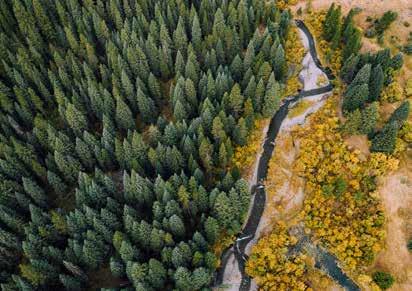
What is LMLC doing for drought preparedness in the face of climate change and water supply concerns?
Lone Mountain Land Company recognizes the precious nature of our limited water supply and takes seriously its role to implement state of the art conservation efforts in partnership with respected environmental nonprofits. All the LMLC communities wisely manage water resources to the benefit of the Big Sky community, as well as all downstream users.
We recognize that using valuable drinking water for practices such as irrigation and snowmaking are archaic in light of today’s incredible technologies to purify reclaimed water. For example, all the golf courses in the LMLC Big Sky communities utilize reclaimed water for irrigation. This is a tremendous investment in time and resources and is managed carefully under strict state approvals to ensure that valuable ground and surface waters remain available for human consumption in Big Sky and for downstream users. Most major cities in Montana directly dispose of treated water into the rivers. In fact, Bozeman can put up to 8.5 million gallons of treated wastewater per day into the East Gallatin. Instead of pumping directly into the river system, LMLC and the greater Big Sky community has chosen to recycle this water for additional environmental benefits to the land and ultimately the watershed. We understand that recycling water is one of the key practices to create a more drought resistant environment in the Mountain West, while maintaining a healthy Gallatin River. As the U.S. EPA recognizes, water reuse “provides tremendous environmental benefits.”
Yellowstone Club’s reuse of reclaimed water for snowmaking actually prevents nutrient pollution by feeding the nutrients to vegetation, rather than directly dumping them into the river. For example, it reduces the need for artificial fertilizers to maintain healthy vegetation, and it decreases groundwater withdrawals from the aquifer that otherwise would be necessary for irrigation—YC’s recycled snowmaking program saved approximately 81 million gallons of groundwater in 2023 alone. Conserving that groundwater helps maintain healthy watershed function and provides water for downstream uses—including drinking water, trout habitat, and local agriculture.
Instead of discharging treated wastewater directly into the river, Big Sky has chosen to be a “zero direct discharge community” as a community-wide initiative with many partners and led by credible environmental organizations. LMLC as a company is proud to be a part of this progressive and forward-thinking strategy that we hope will be a model for other communities across the West.
Dear Editor,
In advance of their Annual Meeting, BSOA recently sent a letter to all Members from the Chairman of the Board. In that letter, the Chairman refers to authorization of a 5% special assessment to pay for speed tables on Little Coyote Road—a project which resulted from a traffic study in 2017. The letter gives the impression that speed tables will not be installed because the Little Coyote Traffic Safety Group has ‘refused to contribute’. That statement is purposely misleading. The Little Coyote Traffic Safety Group is a homeowner task force that does not collect dues, does not have a budget, is not a fund-raising organization, and is thus not in a position to contribute or refuse to contribute to the cost of any BSOA project. However, individual members of the group have in fact contributed personal funds for speed tables on top of the dues they have paid since 2017.
The letter doesn’t mention that BSOA has failed for six years to budget for and manage implementation of the speed tables deemed necessary to reduce liability and risk on a road used by most of the Big Sky Community—not just direct access homeowners. According to their BSRAD funding application—BSOA’s initial plan was to use $53,000 from capital reserves to pay for speed tables. Now the plan is to use zero from capital reserves, hit all homeowners with a maximum special assessment and mandate additional donations from homeowners.
BSOA’s Articles of Incorporation clearly state the HOA is responsible for ensuring safety on the roads within their jurisdiction. Despite that fact, safety is being held hostage by a political agenda—the Board has communicated often they will not install speed tables without additional homeowner donations because they don’t want to create an obligation to do the same in other BSOA neighborhoods.
As a BSOA member—I have questions:
Why are zero capital reserves allocated for the project when members were told at last year’s annual meeting that BSOA had over $600,000 in reserves?
Why did BSOA not budget and accrue funds specifically for these safety devices starting in 2017?
Where did the $600k+ in capital reserves go? Was it used for something more important than safety? Did it go toward the pond ‘activity center’ which the letter describes as an extraordinary achievement from last year?
Why does the Chair’s letter not specify the dollar impact per household of the special assessment? Could it be that dissension between LCR homeowners and non-LCR homeowners was the real goal? Specifying a one-time special assessment of about $27 per household probably wouldn’t generate the discord that fear of a 5%
special assessment and blaming certain homeowners does.
More importantly, why is a special assessment needed at all when $47,000 in BSRAD support and $81,000 from Capital Reserves would get the job done?
As the community anticipates continued growth— our HOA should be identifying and implementing safety policy for all BSOA neighborhoods instead of playing a shell game with homeowner money. Surely the board has learned from the speed table debacle that waiting for prices to go down is not a good strategy.
The irony of the paragraph in the letter chastising homeowners for being “solely concerned for their own neighborhoods” is not lost on this reader who sees the real intent: create conflict between the neighborhoods by pointing fingers and failing to mention that Little Coyote Road is unique with traffic volume now comprised of far more than just direct access homeowners.
The BSOA ‘Letter from the Chair’ to all members is shameful gaslighting and an attempt to excuse six years of project mismanagement and irresponsible allocation of homeowner dues.
Jan Weber Little Coyote Road Homeowner Big Sky, Montana
To the Big Sky community,
On July 28, the Gallatin River Task Force hosted our 12th annual Hooked on the Gallatin, the summer celebration of the Gallatin River, and our opportunity to convene community supporters, give project updates, and share successes for the preservation and restoration work for the river, inviting people to give back to the community resource that they love.
As in past years, the event brought together an impressive crowd of community supporters, lovers of the Gallatin, anglers, businesses, out of town guests, and forever friends of the organization and our work to protect and conserve the river. It was an evening that returned the fundraiser to the banks of the Gallatin, hosted at the Riverhouse and offering some of the best up close and personal views of the river we have.
We included a powerful all-women panel that allowed us to take a deeper dive into what kind of work is most relevant to the Gallatin’s future health, how we continue to use science, data, and visuals to address challenges, identify solutions and bring about real change, and how partnerships are key to all of it.
We enjoyed the company of friends and advocates, sharing our work and our dedication to the projects that protect our watershed, and emphasized the critical nature of community collaboration. We shared how our vision for a healthy Gallatin is not realized without all of us working in sync, together.
The Task Force has this one opportunity each year to put the Gallatin at center stage, and while fundraising is a fundamental piece, so is showcasing our work, our team, our advocates and stewards, and our community partners who all make the work possible.
At the end of the night, we raised critical funding for our projects and initiatives, and were reminded that in all that we do, we know that every dollar counts, and every way in which we envision a healthier Gallatin doesn’t happen without the perfect balance of community engagement and community investment. Our gratitude is running deep on the heels of this event, and we are humbled knowing that our projects are now supported by more than $220,000 that was raised as a result of this event.
While we reflect on this year’s celebration, we look ahead to the work for the Gallatin, and extend gratitude and ongoing hope, knowing that this community has once again stepped up to help us continue our work for the river.
With gratitude,
The Gallatin River Task Force
Big Sky, Montana
BY JACK REANEY
BIG SKY—If you’ve heard a popular song with parody lyrics about Big Sky, that was probably Terry Stebbins, who was much more than the guitarist writing the soundtrack to Big Sky après gatherings.
But, of course, he nailed that role.
“He, to me, is what skiing is about,” said Brian Stumpf, a local musician who played occasionally with Stebbins in the early 2000s, before Stebbins moved away. “Being with your friends, you know, going to the bar when you’re done skiing and having drinks.”
In the early 2000s, Stebbins began writing more than five dozen parody songs about “gapers,” dirtbags of Big Sky, doing the “Swifty dance,” skiing the Gullies, fighting—and losing to—patrol, fields of powder, Bridger Bowl and Jackson Hole, “TramZilla” and a host of local characters. Back then, Stumpf said it only felt like 100 people skiing at Big Sky Resort. And after last chair, they all went to Stebbins’ set.
“His legacy was the vibe,” Stumpf said. Stebbins wasn’t a musical genius or pretentious, he was just a “big ball of happy” who thrived on bringing the Big Sky community together.
When Stebbins would finish a gig, it could take him two hours to walk from the stage to the door, according to Jon Parvin, former bass player for Terry Stebbins and the 420 Crewzers.
Stebbins would talk to every single person, and it wasn’t small talk—he’d talk for minutes between songs too, giving shout-outs and toasts to specific members of the bar crowd. To keep the party going, he sometimes dragged out his final song excessively, to the dismay of bar managers.
“People felt part of it. There was a catchment of the ski community that he bound together so well,” Parvin said. “He’s a legend. He had a special talent to deliver the love of skiing and friends, and the community.”
Emotion gripped Parvin as he recalled the “rock star feeling” of playing to a crowd truly captivated by the quirky, local-must-see frontman. Behind Stebbins, Parvin felt like a member of the Rolling Stones.
“But it was just our little community,” Parvin said. “This wouldn’t work at Bridger. It was all Big Sky.”
Justin Nett, another good friend, said Stebbins’ lyrics were a guide to Lone Mountain. For Big Sky skiers, his five “Ski-Ds” of parody songs felt like a soundtrack to their life.
“You’d get off the mountain on a powder day, and you’d have Terry basically singing about this awesome day you had. He was able to really get into the hearts into the minds of the local crowd,” Nett said.
Stumpf, Parvin and Nett all independently share a favorite parody: “I’ll Ride the Tram,” to the tune of Modern English.
In the song’s chorus, Stumpf said he’d often substitute the adjective: “We skied the Gullies, and they’re gettin’ [better, sicker, deeper, smoother, etc.] all the time.”
“You set your drink down, you stop talking to your

buddies, and you get on the stage and dance to that one,” Nett said.
Stebbins didn’t only sing about Big Sky. When he moved to Hawaii with his wife, Meghan, he wrote surf parodies about the North Shore of Oahu. Still, Nett believes Stebbins hit the nail on the head in Big Sky.
When Stebbins left in 2007, Big Sky didn’t forget his music.
“The legend of Terry Stebbins just exploded at that point,” Stumpf said.
Stebbins would return to Big Sky every year or two for “Powder Fiesta,” a gathering of friends for skiing and music. He once played every day for two weeks—but only at two or three Big Sky venues. Friends made T-shirts of his “tour” schedule.
“It was like 15 dates, but it was only like three different venues,” Stumpf recalled, smiling.
Of course, every show was packed. “He was unique, he was comical, he was well put together with his music,” Nett said. “And he practiced what he preached, and he did a damn good job of it.”
Pono
As a husband and father, Meghan said Terry was “epic.”
He lived out his values. Especially through his 2018 diagnosis with stage-three colon cancer and the ensuing six-year battle, Terry wanted to show his love for his family and for life. He didn’t have a bunch of things he needed to say to family and friends before passing away, Meghan said, because he already showed his love every day.
“I think the kids will always remember Terry for always being told that they were loved, and always being told that they were epic. And I don’t think you can ask for anything more than that,” Meghan said.
The family constantly says, “love you” in passing. They believe in “pono,” a Hawaiian term representing the
pursuit of balance and doing what’s right. If balance is lost, the family believes in taking immediate action to fix it. If a family member does wrong, another often says, “reboot,” as a reminder to put mistakes in the past and move forward with positivity.
Battling cancer, Terry was mentally fierce and immune to negativity.
He adopted a plant-based, vegan diet—in a 2023 interview with EBS, Terry called that a successful “Hail Mary pass” —and began practicing breathwork and meditation. His oncologist believes those actions made a difference, allowing him to survive six years after a grave diagnosis with nearly stage-four cancer. He was at the beach all summer in 2023, juicing six pounds of carrots per day.
Meghan is grateful that her kids, Poppy and Koa, never had to see him looking sickly. “He wanted to be active, he didn’t want to be sitting on the couch… He wanted them to see that he was going to be himself.”
In January 2024, Terry skied in Big Sky. In February the family skied twice together, and he was surfing in March. He never caved to his terminal illness. He lived life to the fullest and showed strength despite being dealt a tough hand, Meghan said.
On June 19, Stebbins lost his prolonged cancer battle. He was 54.
He was celebrated by the community of Marshfield, Massachusetts, the Stebbins’ home since 2015. A family friend and owner of Levitate, a surf shop and music festival producer, organized a “paddle out” on June 23.
A common rite in the surf community, a paddle out is a chance to share stories among community members, and to hoot and holler in Terry’s memory, Meghan said. A large crowd assembled on Rexhame Beach.
Many attendees surprised Meghan—she didn’t realize they had known Terry, but they shared how he made a positive impact on their lives, even just through one small moment.
“It was really a testament to honoring Terry, and how much Terry meant to everyone… He really saw the good in so many people,” Meghan said. He elevated those around him.
Rexhame Beach doesn’t get many waves in the summer, but little ones showed up that Sunday morning. Even the non-surfers had the chance to catch a wave or two.


“Terry definitely had a hand in that,” Meghan said, again emphasizing her husband’s “epic” spirit.
“He had this special ability to enlighten people,” Parvin said. “And then he got cancer. I think just his spirit and his flow kept him living longer than anybody would have lived.”
Nett believes people who knew Terry are happier, and better suited to face hardship.
Toward the end of his life, Terry recorded a video to share gratitude for his Big Sky dirtbag friends. He sent it to Nett, asking his friend to pass it along in Big Sky.
“He knew what he looked like, but he wanted me to see it, he wasn’t afraid,” Nett said. He cried for about 15 minutes after watching the video.
Then, he realized that Terry wouldn’t want him to sit around and cry.
“He’d want me to be out having a good time, celebrating all he did for us,” Nett said. “… He’d want us to sing his songs, be outdoors, ski powder.”

Stumpf said friends plan to sing his songs every winter to keep his legacy alive.
Meghan believes that she, and her two kids, will always feel the love for Terry in Big Sky. Even though the kids only visited a couple times, she knows Big Sky impacted them. The family plans to return to Big Sky in March 2025.
“Terry passed with a smile and I think that’s because he knew all the people that he came in touch with… will always look after Poppy and Koa and me,” Meghan said.
Nett wrote a list of memories about Stebbins: he’d shout “Hi-yah!” and bar patrons would echo; he’d count inches of snow in a Muppets’ Count von Count voice while somebody flickered the lights; he impersonated the region’s terribly inaccurate radio meteorologist; he and the Crewzers once played a triple set in a single night— first at Chet’s Bar and Grill, then Scissorbills, then Black Bear Bar and Grill.
Stebbins was the perfect show for the dirtbags all over the world, Nett wrote.
“We loved him as much as we could love any musician. We couldn’t get enough of him. We couldn’t believe this was real.”


BY JEN CLANCEY
BIG SKY—Around the corner from the food aisle in the Big Sky Community Food Bank sits a washer and dryer in a closet next to the resource center’s kitchen. The machines are a standalone pair in Big Sky—they are the only public self-serve laundry machines within 30 miles.
Sarah Gaither Bivins, the operations manager at the food bank, explained that the machines were replaced in 2022 after renovations to their location in the Big Horn Shopping Center. With a focus on keeping customers fed, providing quality food and connecting them with resources, Bivins knows that the lone washer and dryer serves an essential service, though limited in hours, after Big Sky’s only public laundromat closed in 2022.
Sit and Spin Laundry Lounge, a retro bar paired with a public laundromat, opened on June 16, 2018. The hours were worker-friendly, open from 11 a.m. to 2 a.m., later changed to 1 p.m. to 2 a.m., seven days a week. The business welcomed patrons to start their laundry, sit and buy an alcoholic beverage if they felt inclined.
Sit and Spin closed in 2022, leaving a clean-clothes void in Big Sky. For those without a washer and dryer their options include the food bank’s laundry services, a drive through the canyon for self-service laundry, pickup and drop off services from Bozeman or West Yellowstone businesses, or a friend with a washer and dryer to help them out.
Depending on the season, the food bank will see three to five people use the washer and dryer a week. It’s affordable—$1 to wash and $1 to dry—but that show of demand is limited by the food bank’s hours, Bivins explained.
“We’re only open four days a week and we have short hours. It’s hard to get a whole load done, or multiple loads done,” Bivins said. “I think a lot more people would use it if we had more hours.”
Bivins estimates that their service could be used by anywhere from 10 to 20 households if it operated with more hours and notes that the customers come for a variety of reasons.
“We’ve seen all of those things—people living in their cars, people whose laundry at their facility is broken or full and people who don’t have laundry [machines],” Bivins said. She notes most customers are living in their cars, a population of folks that grows higher in the summertime to at least 20-25 in Big Sky, and dips in winter months.
Laundry as an essential service is easily overlooked, Bivins said, describing what it feels like to show up to work in clean, fresh clothes and how that can be taken for granted. In recent years, the demand for the food bank’s overall resources has increased—2023 winter saw a 97% increase in use of its services—which Bivins connects to inflation, cost of food and increase of employees. It’s a demand that has stretched the food bank to provide for other needs like affordable clothing.
Bivins hopes that the food bank can return to its core mission of assisting with food access as other nonprofit organizations like Big Sky Thrift and Wellness in Action open complementary resource centers.
A potential solution for a laundromat is noted in the 2023 Big Sky Capital Improvement Plan.
In collaboration with the Human Resource Development Council, a nonprofit dedicated to building resources and supporting communities in southwest Montana; and the Big Sky Behavioral Health Coalition, a group that supports behavioral health services, the plan outlines human resource needs for Big Sky. Included in the list of needed facilities is an emergency shelter, which lists laundry along with showers and hookups.
“There have been several community conversations about the need for some type of emergency shelter,” Bivins said.
Community partners need to decide on factors such as regulations for clients in the facility, staffing, location and



safety of the building itself. The timeline for the emergency shelter is between 2023-2028.
Meanwhile, employers, residents and businesses make do.
When Lone Mountain Land Company housed employees at River Rock Lodge, they included a laundry pickup and drop off service within the housing package. Employees no longer live in the lodge, and Tara Ayers, who’s worked as operations manager for a year at LMLC, explained how the company treats laundry as non-negotiable in both community and employee housing.
“So … every unit has a kitchen, every unit has [what] I call in my world—because I do a lot of resident experience stuff—the necessities and the niceties,” Tara said. “So necessities are laundry services and being able to cook and having access to those things.”
LMLC’s 511-unit, 2,000-bed portfolio of workforce housing spanning Big Sky and Gallatin Gateway are equipped with in-unit laundry or onsite services, according to Ayers.
Some may take the trip to Bozeman’s four-strong laundromat scene, about a 55-minute drive. One of these laundromats, Duds N Suds located at 503 S 23rd Ave., 31 miles from Big Sky, includes self-service operation as well as pick-up and delivery services to southwest Montana areas like Big Sky.
“We just have a really loyal and wonderful customer base,” Ballenger said, adding that just the other day a customer brought donuts to employees. It’s the end of June and there’s a fresh coat of paint on the 3,300 square foot facility. Parking lines are touched up in the lot and three apple trees are growing on schedule for casual harvest in the fall.
The pair purchased the business four years ago and noted that the renovation and takeover required significant investment.
“You’re gonna have to have a lot of money to be able to invest in the infrastructure … there’s so much behind the scenes,” said Ballenger, noting the investments in two large boilers, a soft water system, and a salt operation. Luckily his partner Binford is apt in taking care of mechanical issues that happen with the machines, which is a common occurrence.
“There’s usually something a couple times a week,” Binford said.
Not to mention, there is a hefty but worthwhile price tag for modernization. Technology streamlines the business’ wash, fold and dry operation to four service areas all while the self-service side of the business continues.
Duds N Suds is quarter-free. It operates through a loyalty card system that customers can add money onto and earn cash back. Ballenger said Duds N Suds was at the forefront of these technological advancements in laundromats. Customers can also directly make an order for laundry pick-up and services online, and can control details down to laundry detergent type and folding style.
The owners also operate the neighboring Duds N Suds car wash and a pet wash on the property.
“This place has always had a good reputation of being really clean,” Binford said, explaining that making the customer experience personable and relaxing is key.
Overall, Binford and Ballenger describe joy in being able to help and connect with people and take pride in the growth of their 10-12 employees who can earn commission, tips and have access to benefits like health care and a Roth IRA.
Binford and Ballenger consider Big Sky a place of growth for the pick up and delivery side of the business, where they currently run one truck between Big Sky and Bozeman.
When it comes to the feasibility of a laundromat resurrection in Big Sky, Ballenger and Binford’s experience rings true. A potential laundromat owner would need to invest about $18,800 for two washer machines and about $47,000 for five machines, according to Big Sky County Water and Sewer District General Manager Ron Edwards. Edwards has worked with the water and sewer district for almost 30 years and is familiar with the fees required for new facilities and homes in Big Sky.
The calculations for washer machines begin at the defined single family equivalent per machine, Edwards said.
Then this number is multiplied by the connector fees established in July 2022. Add on the water charge for each hookup per washer machine and totals already are in the tens of thousands upfront.
This number doesn’t include the cost of the machines themselves, their maintenance, rent and the subsequent water bills.
Big Sky is an outlier in mountain communities nearby. Madison Laundry & Dry Cleaners operates in Ennis and there are three businesses in West Yellowstone: Little Ducklings Laundry, Canyon Street Laundromat and Showers, and Fox Den Laundromat and Showers.
In the meantime, Big Sky’s washer and dryer will be chugging away at the back of the food bank for those who need it.
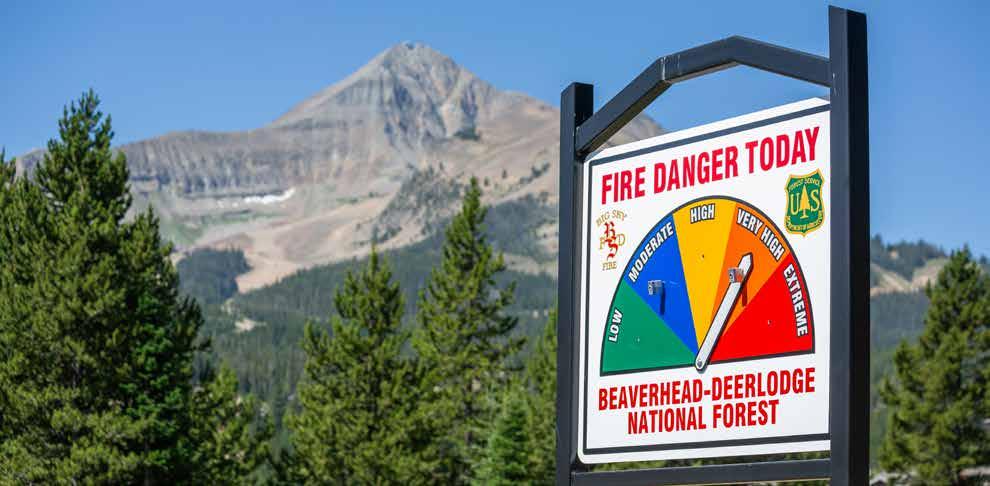
BY MARIO CARR EBS CONTRIBUTOR
BIG SKY—Amid a prolonged dry and hot summer, Big Sky Fire Chief Dustin Tetrault is calling on residents and guests of Big Sky to take personal responsibility by recognizing the current fire danger and doing their part to prevent a wildfire, as well as being prepared in the event that a fire does break out.
The Fire Adapted Big Sky Wildfire Hub—a website—is a central location where the Big Sky community can stay up-to-date on current fire danger, air quality conditions, as well as find helpful information on how to better fireproof their homes and properties and learn how to pack a go-bag should an evacuation be necessary. Additionally, Tetrault highly recommends that anybody living in or visiting Big Sky should sign up for the Gallatin County Emergency Notification System.
One point of emphasis in wildfire preparedness is knowledge of the areas of refuge in the event of an evacuation. With U.S. Highway 191 and Jack Creek Road the only roads in and out of Big Sky, residents are encouraged to utilize areas of refuge in the event of a wildfire-caused evacuation. These areas include the free skier parking at Big Sky Resort, BASE community center, the Big Sky Golf Course and Lone Peak High School. Tetrault explained that these areas were chosen due to their size, their noncombustibility and fire protection features.
“When it comes down to wildfire response and preparedness, it’s not just the fire department—it’s the entire community,” Tetrault said.
A hot and dry July created very high danger throughout Big Sky.
“We just came out of the last two weeks of probably some of the hottest weather on record that we’ve
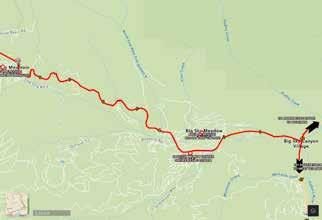
had around here… We haven’t really had any substantial moisture since before the Fourth of July and it looks like more of the same for the next few weeks,” Tetrault said in late July.
With these conditions Tetrault is continuing to emphasize diligence and care, especially when we consider how long our fire season can last.
“The last few years, even in September, we've been pretty hot and dry with more of an extended fire season and fire risk,” he said.
Mindfulness is key, Tetrault said, and he’s calling everyone in Big Sky to keep every possible ignition source in the back of their minds at all times. Beyond that, the fire department is looking for more community members willing to take an active role in preparing and educating their peers.
The Fire Adapted Big Sky Wildfire Hub has been working to educate the community through corporations, HOAs and Neighborhood Ambassadors. Mel Crichton is one of 11 NAs in Big Sky, and he has worked close with the fire department to help spread as much knowledge
as possible on how to prepare and prevent fires. Crichton wants to help the HOAs in Big Sky prepare action plans for fire response in their neighborhoods, and he said this requires the community to rally around neighbors that may need more assistance in the event of an emergency.
“Most of the deaths in wildfires come from people who don’t evacuate, and most of those people are old or compromised,” Crichton said.
Another hazard is the smoke during fire season, which is harder on the vulnerable people in the community. Fire Adapted Big Sky aims to help anybody seeking some relief from the smoke with instructions on how to create their own air filters.
The smoke levels around Big Sky are currently moderate and near average, according to Tetrault, but could change in the coming days.
Starting July 31, Fire Adapted Big Sky will have an information tent at the Big Sky Farmers Market through September where they will be spreading the word about how to prepare for and prevent fires and get involved with community engagement.
Crichton encourages anybody interested in fire safety and caring for their neighbors in the event of an emergency, to consider becoming an ambassador.
“We’re just trying to recruit enough to get a reasonable saturation into the community, and we’re really looking for the go-getters,” he said.
One can never be too prepared for a fire, and that is why the Fire Adapted Big Sky Wildfire Hub exists and is eager to share as much information as possible with everybody living in and visiting Big Sky.
“Number one is evacuation and safety,” Crichton said. “Number two is getting your home ready in case a fire does come through."
BY JACK REANEY
BIG SKY—On July 24, the Big Sky Fire Department promoted two of its own, swearing in Dustin Tetrault as fire chief and David Parker as captain paramedic and training officer.
The ceremony was short and sweet—it became savory when firemen carried in boxes of Blue Moon Bakery pizza—and officials celebrated their confidence in the future of BSFD.
After retiring in May, former Chief Greg Megaard believes the department is in good hands thanks to Tetrault’s leadership ability and background.
“He hit the ground running the day he was offered the position,” Megaard told EBS after the ceremony. Departments must sometimes make an outside hire that would involve gradual onboarding, learning the nuances of the district and its service area.
“We don’t have that here,” Megaard said. “He stepped right into the role. And you always hope it will be better than when you found it… He’s got all the skill sets, all the confidence, and I believe all the support. I think the future is bright for Big Sky Fire.”
Chief Tetrault has served with BSFD for almost six years and brings two decades of experience in fire service. He recalls handling COVID restrictions and helping the county with the COVID response alongside Chief Megaard. The pair were sometimes the only two in the front office during the pandemic—one of the “wildest experiences” they’ve ever faced in their careers as first responders, Tetrault said.
Megaard said Big Sky’s growth and development will continue to be a challenge. Call volume has doubled since Tetrault started six years ago—from roughly 700 to more than 1,400 calls per year.
“The amount of people coming into this community is staggering,” Megaard said. “And all those people coming in to recreate, to live, whatever it is—that’s a demand on services for law enforcement and fire.”
One of Tetrault’s priorities will be the implementation of a five-year strategic plan. He’s hoping to collect as much feedback as possible through an online survey to make sure the department continues to grow sustainably in alignment with community demands, as it has in response to Big Sky’s booming population.
“We’ve really just changed to meet the demands of the community, and we take a lot of pride in that,” Tetrault said.
The new fire chief’s other priorities are to oversee the construction of a third fire station in the Spanish Peaks Mountain Club area, and to improve insurability for Big Sky homes.
The Big Sky Fire Department has been planning the Big Sky Fire Station No. 3 in Spanish Peaks since 2016. It’s a collaboration between BSFD, Lone Mountain Land Company and the property owners in the area of the Spanish Peaks Mountain Club, who will fund the station through a rural improvement district, or RID.
Tetrault said using an RID to construct a fire station is unprecedented in Montana.
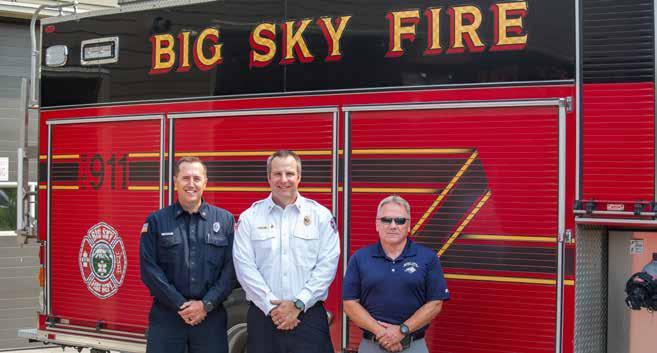


“A lot of other fire departments in the state are looking at that as a potential model to build fire stations,” he said.
On insurance, Tetrault said the department is close to earning a higher-level fire protection class rating. Currently, much of the area is rated “ISO 4,” and a better rating would reduce insurance premiums and improve insurability for Big Sky homes.
“We’ve already made moves—with our reserve ladder truck, and with this extra station, extra staffing—to really try to get to that ISO protection 3 rating,” Tetrault said.
Alan McClain, board chair of the Big Sky Fire District, said Tetrault brings experience, technical skills and great rapport with firefighters.
“He has a real knack for technology and the contemporary world that we live in,” McClain said. Tetrault continues to engage with the community
through programs like Alpenscapes and the Fire Adapted Big Sky Wildfire Hub, and by often setting up a booth at the Big Sky Farmers Market.
As budget becomes a larger issue with the growth of the district—40 full-time staff with another three or four hires planned every year—McClain said Tetrault is fiscally minded.
“Having a person with a good mind for the budget is a big deal for the department and our community,” McClain said.
Megaard said the department will continue working toward accreditation, a process of turning the department “inside out” to find areas for improvement.
“That was part of my retirement decision was the great hands that this department is going to be in, with Chief Tetrault, Chief Barker, and the rest of the team here,” Megaard said.
David Parker promoted
David Parker has been involved with the Big Sky Fire Department for seven years. He previously served as a firefighter paramedic, and on Wednesday was promoted to captain paramedic and training officer.
“This promotion is probably my biggest accomplishment,” Parker told EBS. However, as a firefighter he worked to develop certain programs including rope rescue.
“We didn’t have a real capability to remove victims from below grade on hills and slopes and stuff like that. We relied on search and rescue,” Parker said. “And I was able to use my experience from another department and system, to bring that here.”
With his new role, he will oversee training department-wide. It’s a full-year training schedule including exercises for structural firefighting, wildland firefighting, EMS, driving and pumping fire engines, and various technical rescues.
“This fire community has really impressed me with their growth, and the way they’ve maintained quality leadership through that growth,” Parker said. “Every single officer, and every single firefighter has been super supportive and instrumental in getting me here. I absolutely couldn’t have done it without the current leaders and firefighter line guys.”
BY JACK REANEY
BIG SKY—A planned Big Sky housing development would include 264 apartments and 125 single-family homes, all deed-restricted and exclusive to local workers. If the project progresses on schedule, homes could be ready as early as 2027.
The development, known as Cold Smoke, is being planned by Lone Mountain Land Company and the nonprofit Big Sky Community Housing Trust. It was first announced in April at LMLC’s Community Development Open House, and took a step forward July 29 as partners submitted an application to annex land into the Big Sky County Water and Sewer District.
On July 16, housing trust Executive Director David O’Connor and LMLC Director Cryder Bancroft discussed Cold Smoke in a BSCWSD board meeting.
As planned, Cold Smoke would include two sections: apartment buildings and a neighborhood of single-family homes.
Apartments would be built near the new RiverView Apartments, beside the South Fork of the West Fork of the Gallatin River.
Buildings would include roughly 264 one-, two- and threebedroom units. Based on demand, construction would prioritize one- and two-bedroom apartments and studios, O’Connor explained to the board.
“We’re not looking at creating more dorm-style product,” O’Connor said.
Developers envision those apartments would mostly be rented, but the business plan is still in progress and some units may be available for purchase. Rent would ideally not exceed 150% area median income, depending on subsidies available.
Across the river to the south, Cold Smoke would include roughly 125 detached homes, available for rent and for purchase.
O’Connor said it’s difficult to determine sale price before knowing what public subsidies will be available. The goal will be to sell homes at 150% to 200% of area median income, which roughly translates to resale price of $400,000 to $600,000.
“The idea would be to make that affordable to as wide of an income range as possible,” O’Connor said. “Our workforce tends to max out at 225% or 250% of area median income… so we would seek to provide affordability certainly below that.”
The housing trust would steward the entire project by managing applications and compliance, and negotiating affordability. All units would be deed-restricted, including mechanisms to preserve the permanent affordability of for-sale units.
The entire project would be reserved for local workers with short-term rentals permanently prohibited.
‘If not this, then what?’
Cold Smoke would bridge roughly one-third of Big Sky’s workforce housing gap.
Based on Big Sky’s housing needs assessment, created in 2018 and updated in 2023 by the housing trust, the community needs roughly 1,300 additional housing units by 2028. Cold Smoke could account for nearly 400.
After completing RiverView, the housing trust is still entitled to roughly 400 single-family equivalents of water and sewer rights to develop workforce housing—the SFEs remain from a pool of 600, earmarked in 2020 through the “1% for infrastructure” agreement between the Big Sky Resort Area District and water and sewer district. O’Connor often says that housing clause was the smartest thing the community has ever done.
Cold Smoke would essentially exhaust the remaining 400 SFEs.
O’Connor said Cold Smoke represents the housing trust’s best ability to use those SFEs to deliver affordable workforce housing across a broad spectrum of income and tenure, and in the quickest time frame possible—even if the project receives approval and final entitlements in 2024, initial occupancy would not be likely until 2027, “just magnifying that need to get started,” O’Connor said.
He added a rhetorical question to the BSCWSD board. “If not this, then what?”


As for concerns of large-scale development in the wildlandurban interface, Bancroft said they’re taking steps to be responsible and sustainable stewards of the land. They will explore a collaboration with Alpenscapes, a new partnership of four local organizations—Big Sky Fire Department, Big Sky Sustainability Network Organization (SNO), Gallatin River Task Force and Grow Wild—that encourages alpineappropriate landscapes that are collectively appealing, fire-safe, water-wise and ecosystem-friendly.
Bancroft is also confident that from the road, Cold Smoke will hardly be visible to passersby. It will, however, impact traffic on Montana Highway 64 (Lone Mountain Trail), likely requiring a new stoplight or traffic control mechanism in front of the RiverView Apartments. Skywood Road will serve as a secondary access route.
If not for Cold Smoke, O’Connor explained, this land would likely be developed into low-density, high-end market rate residential housing.
“Of which we have a significant amount in this community,” he said. “We feel this is a better opportunity to provide something we need.”
Bancroft said Big Sky is in “crisis mode” for affordable housing as it struggles to attract and retain families and employees.
Owning a Cold Smoke home would be the next stepping stone for local workers as they begin raising children and theoretically outgrow MeadowView Condominiums— workforce-owned, deed-restricted housing near Big Sky Community Park.
Water and sewer district board member Al Malinowski asked if MeadowView, the housing trust’s most similar project, has been perceived as successful.
“Wish we had built 500 of them,” O’Connor responded. “I think by every single measure [it] has been successful. Sold out very quickly with a waiting list by 2021.”
Bancroft said Cold Smoke presents a great opportunity to support the working community through housing that is 100% deed-restricted, and 100% open to the public.
“The right product type for families [and] individuals, in a great location,” Bancroft said.
O’Connor said the “significant” open space in the parcel presents an opportunity for partnership with the Big Sky Community Organization and similar groups to increase parks and trails infrastructure and connectivity.
“I personally find [it] impressive that people can point to our workforce housing and say that it’s got one of the main amenities that some of our highest-priced housing in the community offers,” O’Connor said.
Board member Peter Manka asked a question that went unanswered during the Cold Smoke project’s initial public presentation: if Cold Smoke is annexed into the water and sewer district, how will the sewer pipe cross the river?
“There’s a bridge that currently exists,” Bancroft responded. “So we could either go across that bridge or bore under the river. And we’ve been talking to Johnny [O’Connor] and Ron [Edwards] about that over the last two months.” Edwards and Johnny O’Connor are general managers of the water and sewer district.
With BSRAD, the housing trust is exploring potential bond funding to fully acquire the land. Community land ownership translates to greater affordability and control, David O’Connor explained in a follow up call with EBS.
Even if the public cannot acquire the land through the housing trust, O’Connor said the rules set in place with the 600 workforce SFEs will ensure the product is delivered—and restricted to local workers—as promised.
Board member Mike Wilcynski asked if there’s any land already inside the water and sewer district that could be devoted to 400 SFEs of employee housing development. O’Connor said it appears this is the only viable option for a project of such scale.
Bancroft said receiving a zoning permit is not a concern: the area was originally zoned for higher density and overall scale, and the amendment being requested would enable the shift of higher density toward the area of the apartment buildings. The other area would be built significantly below allowable density.
In late June, the housing trust submitted a zone map amendment to the Gallatin County Planning and Zoning Commission. It will be discussed in September.



BY FISCHER GENAU
BIG SKY—Big Sky Thrift will donate $64,400 to various local organizations through its latest grant cycle, adding to the $75,000 granted last December to support the Big Sky community.
“These grants are a testament to the hard work and dedication of these organizations in making Big Sky an amazing place to live,” Emily Burke, associate director of programs for the Yellowstone Club Community Foundation—which operates Big Sky Thrift— stated in a press release.
Grants include $50,000 to Riley’s Urgent Fund for Friends (RUFF), $6,400 to the Big Sky Community Organization, and $3,000 to both Ophir elementary and middle schools.
Over 65 volunteers voted to determine how to allocate grant money, all of which comes directly from sales of secondhand goods.
RUFF will use the money to support its animal shelter services, while BSCO is putting grant funding toward supplies for Camp Big Sky, its summer-long camp that offers games, art and outdoor exploration. The money awarded to Ophir Elementary School will help build a

new, bigger trout tank that the public can view as students raise trout eggs into fingerlings before releasing them in the spring. Ophir Middle School will use its $3,000 to pay for counseling workbooks for its students, which focus on health and wellness.
“We are honored to support their efforts and look forward to seeing the positive impact they will continue to have on our community,” Burke stated.
Aside from Burke, Big Sky Thrift is entirely volunteer-run, and Lone Mountain Land Company provides commercial space to
Big Sky Thrift free-of-charge, allowing more money to be funneled from sales revenue to nonprofits.
“We’re super fortunate that we don’t have to pay rent, so our revenue gets to go back into the Big Sky community,” Burke said on the phone with EBS. “And we really thank all of the volunteers who put in their hard-earned time to make this thrift run.”
Information about Big Sky Thrift’s fall grant cycle will be released in the coming months, and anyone who wants to learn more can visit bigskythrift.com
BSFD AND AGENCIES DODGE ‘HUGE BULLET’ THROUGH RESPONSE TO MORNING FIRE
BY JACK REANEY
On July 25, the Big Sky Fire Department and supporting agencies responded to a fire approximately four miles up Taylor Fork Road between Big Sky and West Yellowstone.
The fire was started in the morning by the generator on the back of a vehicle, and responding firefighters discovered a truck and RV “fully involved with propane tanks full,” according to BSFD Deputy Chief Seth Barker. The first responders’ initial concern was the possibility of flames reaching the forest.
The fire reached a minimum size of two acres before being completely extinguished. The U.S. Forest Service remains on scene but Barker emphasized the fire is no longer a threat.
“Dodged a huge bullet today,” Barker told EBS over the phone. On July 24, Gallatin County was included in a red flag warning for critical fire weather conditions on July 25 from noon to 11 p.m., based on low


humidities, hot temperatures, strong gusty winds, a wind shift with a cold front, and increasing thunderstorm activity.
“Thanks to the good hard work of our team, we were able to extinguish it really quickly,” Barker said. He advises against any open fires while camping.
Barker added gratitude for agencies that sprang into action.
“Great thanks to Big Sky Fire, the Yellowstone Club [fire department], Gallatin County 911 and the U.S. Forest Service,” he said. “Big shoutout to the Nine Quarter Circle Ranch for showing up with some water to help us out.”
In addition to sending resources to the scene, the Yellowstone Mountain Club Fire Department also sent extra staff to the Big Sky Fire Department to stand by for 911 calls.
BY JACK REANEY
BIG SKY—The Hillbilly Huckers overcame their dip into the loser’s bracket on Sunday afternoon, Aug. 4, beating Riverhouse twice in the championship, 22-15 and 27-16, to win the 2024 Big Sky Softball League tournament.
Brett Slehofer, Riverhouse team manager, told EBS he couldn’t think of a time when a team emerged from the loser’s bracket to win the whole thing—the feat requires beating the top team twice in a row after playing at least one extra game on the second day of the weekend tournament.
Even Huckers manager Lee Horning was a bit surprised that his team came out on top, considering their “advanced age” with half a dozen 50-plus-year-olds, and a few key players away on vacation.
“Every year we kind of focus on the regular season trophy… Don’t feel we’re built for a lot of games in a row,” Horning said. But they made a run, and Horning said it feels good to get one of the trophies back—they last won the tournament in 2022.
After some tough, unexpected losses early in the season, Horning said the Huckers stayed determined every week and focused on simply scoring as much as possible.
“And that’s what we did,” he said.
Horning credited the Huckers’ young guns, including “outstanding” third baseman Jared Rogers, shortstop Tito Ruiz—who couldn’t attend the tournament—and Ruiz’ power-hitting replacement, Ryan Rothing, who joined Huckers for the 2024 season.
“Derek [Christensen] and Matt [Hockinson], our top of the lineup hitters, they all did great,” Horning said. “And our girls did an awesome job, even though we were shorthanded again, missing Mara [Mitchell] and Kate [Scott], longtime Huckers.”
Horning shouted out Huckers’ ladies Vanessa Wilson, Destini Vega-Climo, Michelle Horning and Kelly Sheedy, as well as pitcher Cord Halmes.
“I tell you what man, they were playing really solid softball all day,” Slehofer said. “We couldn’t keep up with them. Their defense was on point, and their offense was better. They were the better team yesterday, for sure.”

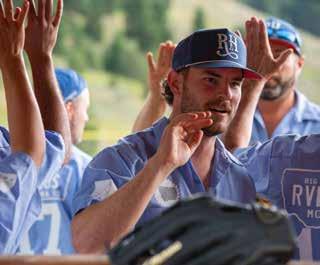
The double-win championship didn’t come easy, though.
Riverhouse took down Huckers in the semifinal game, as a tactical blunder led Horning to intentionally walk in Riverhouse’s winning run—the batter he avoided, Yale Rosen, had two grand slams in the tournament among other tape-measure shots.
Riverhouse was hot throughout the tournament.
“Man, we had a couple defensive plays that were SportsCenter highlights, I tell you what. Our left-center fielder, Yale, and our shortstop [Jake Lorenzini] were on fire,” Slehofer said.
After falling to Riverhouse, the Huckers had to play an extra game just to reach the championship—in which they’d still need to win twice. They defeated rival Lone Peak Cannabis Co. (LPC), 24-9, to set up the Riverhouse rematch on Sunday afternoon.
Steven Reid, league coordinator for the Big Sky Community Organization, which runs the softball league, said Riverhouse improved this year, especially on defense.
“Last year many of their games were kind of shootouts. I think that’s what really bumped them up in the standings [this year],” Reid said.
Riverhouse went undefeated, 13-0, in the regular season. Until the tournament championship, their only loss came to LPC in the regular season championship.
Slehofer explained that Riverhouse tried something new with their lineup this season. Prioritizing the number of


at-bats for the strongest hitters, those with weaker bats shared a lineup spot, alternating turns with each cycle through the batting order.
“And it worked,” he said. “We went 13-0.”
As for next year, Slehofer said he’s not sure what to improve upon.
“But I’d be happy if we did the exact same thing. Win 13 in a row, and have a strong showing in the tournament. That’s a successful year for me, man.”
In the championship, wind howled and lightning bolted across the northwestern sky before an hour-long rain delay. Perhaps the shift in weather gave the Huckers the life they needed for 14 more innings at the end of a long tournament. Or maybe the Huckers are a dangerous team to doubt.
For next season, Reid anticipates a similar 14-team structure, and noted that a few people have expressed interest in starting a team—possibly inspired by the success of the Kenai Kangaroos and BYWOM Knights, both new for 2024.
BYWOM didn’t win until the final week of the regular season, and entered the tournament as the final seed. But they played some ball, winning twice on Saturday and making it into the second day of tournament action.
“That was really impressive,” Reid said. “Chemistry clicking—hope they come back next year.”
Reid reflected on a fun 2024 end-of-season tournament. He noted mostly good weather until the championship and strong attendance, with a Big Sky dose of goodnatured heckling and many games decided by one or two runs.
Given that this year’s softball season ended a few weeks early—the schedule was adjusted for field construction that won’t happen as planned—Reid said BSCO will run pickup softball on Mondays and Tuesdays through the last week of September, except for Labor Day.
Games will begin at 6 p.m., with registration required online. Each game will cost $5 per person, as a fundraiser for the league.
“We’re gonna take advantage of having this field still available, and keep playing,” Reid said.

Featured Residence 203
LISTED AT $2,700,000 2,307± SQFT | 3 BED | 2 BATH
Perfectly located in Bozeman’s Northeast Neighborhood, just a few blocks from Main Street. Wildlands is a truly exceptional location. Conveniently situated near multiple coffee shops, restaurants, trailheads, and within 20 minutes of Bridger Bowl Ski Area, living at the Wildlands means you are never far away from world-class adventure and culture.
The few remaining residences each boast top-of-the line finishes, large living spaces, and meticulous detail. Schedule a tour today and experience the masterpiece that is Wildlands.

Scan here to visit the website for floor plans, virtual tours, and more.



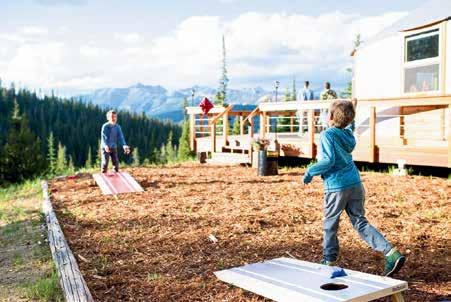

BY JEN CLANCEY
BIG SKY—Wildlands Festival began Thursday, Aug. 1, with a charity dinner and auction, all supporting the festival’s three nonprofit beneficiaries. The evening began with a panel discussion moderated by Hoary Marmot podcast host Joe Borden with Scott Christenson, executive director of Greater Yellowstone Coalition, Emily Cleveland, conservation director of Wild Montana, Chet Work, executive director of Gallatin Valley Land Trust, and lastly Zach Green, president of BeAlive Studios.
The charity dinner under the Big Sky Events Arena tent welcomed Big Sky community members to enjoy hors d’oeuvres, live music and a live auction, and to unite under the cause of protecting Montana’s wild lands.
During the panel discussion, Work discussed how GVLT has incentivized landowners to support conservation initiatives through purchase of land. During the talk, Work mentioned how GVLT “may be able to keep a [wildlife] crossing intact in Big Sky” and that an announcement may be coming soon.
Emilie Ritter, director of communications and marketing for GYC, noted that being a beneficiary for Wildlands allows the organization to connect with new people.
“It has been an honor to be among the conservation nonprofits selected to benefit from this year’s Wildlands Festival,” Ritter stated in an email to EBS. “We’ve been able to share Greater Yellowstone Coalition’s story with even more people who care deeply about protecting this place that all of us love so much.”
In a surprise bidding war between two attendees, a Gibson guitar signed—and strummed later that



evening—by Wildlands performer Lukas Nelson sold for $36,000, with proceeds benefiting the nonprofits. Marie Rowley was the recipient of that guitar, which her brother bid on and gifted to her.
“It’s unbelievable,” Rowley said after hearing Nelson play the guitar and sing some never-recorded songs. Nelson began his mini performance with a song called “Can You Hear Me Love You,” and included another tune about Montana.
“Their willingness to go big for a signed Gibson guitar in the name of conservation was a pretty incredible validation of just how much folks care about Greater Yellowstone,” Ritter said of the $36,000 raised on just that auction item.
Three other items brought the total for the night to over $50,000. Kevin Noble’s wolf photo “Dressed in White” sold for $9,000, a signed Foo Fighters poster and Explore Big Sky cover poster sold for $3,000, and a 2019 Peak to Sky festival poster signed by the likes of Brandi Carlisle and the late Foo Fighters drummer, Taylor Hawkins, sold for $6,000.
In addition, a silent auction included items like a seven-night stay in a private Mexican villa, and a year of freshly roasted coffee by the Milky Whisker Coffee Roasters.
As the Big Sky Events Arena filled with Wildlands Festival concert-goers over the weekend, the festival continued to raise money through donations. On Saturday night, moments before Dierks Bentley took the stage, organizers announced the grand total raised: $303,000.
BY FISCHER GENAU
BIG SKY—Five hundred red solo cups, two dozen dethorned roses, and six green bananas. All of these items were requested by country megastar Dierks Bentley ahead of his headlining set on the final night of Wildlands Festival, a music fest that raised $303,000 for Montana conservation nonprofits and featured acts including Maren Morris, Wyatt Flores, and Lukas Nelson. But the over 3,000 thousand fans packing the Big Sky Events Arena would have to wait until the very end of Bentley’s set Saturday night to see the roses and bananas put to use.
After an hour-and-a-half long performance that included No. 1 country music hits “Drunk On A Plane” (which Dierks sang wearing a pilot’s hat and jacket), “What Was I Thinkin’,” “Beers On Me” (during which he threw cans of Bud Light to the audience) and “Somewhere on a Beach,” Dierks and his six-man band reclaimed the stage wearing shag mullets, leopard-print vests, parachute pants, and other retro attire for a triumphant encore as Hot Country Knights, his parody music side project.
The encore was a country music medley, each band member taking a turn on the mic while hopping, thrusting, and dancing all over the stage. Bentley flung roses to fans while playing, and he pulled a smushed green banana from his pants, signed it in sharpie and threw it into the front row before exiting the stage for good. His drummer, Steve Misamore, remained, taunting one of the stage techs who eventually carried him off to a cheering crowd.
It was an ecstatic finale to two days of music and a threeday celebration of Montana’s wild lands. Before Bentley’s set, Outlaw Partners CEO Eric Ladd presented $101,000 checks each to the Gallatin Valley Land Trust, Wild Montana and the Greater Yellowstone Coalition, the three nonprofits chosen as beneficiaries for this year’s Wildlands Festival.
“The reason we’re here tonight is to celebrate great music and community but also to give back to conservation to help protect this beautiful Montana landscape,” Ladd told the crowd.
“You helped raise over a quarter million dollars to help conserve Montana and Yellowstone Park,” Ladd said. “Let that soak in for a minute. Really, really special.”
The money raised will go towards various efforts to protect Montana’s natural lands, such as wildlife crossings and climate resiliency in the Greater Yellowstone Ecosystem.
“We are all here to appreciate the beauty and it’s all of our responsibility to protect it,” said Bethany Green, GVLT’s development manager, while accepting the check onstage. “You guys showed the heck up tonight, so thank you.”
Lukas Nelson also made a surprise appearance before the check presentation, telling the crowd he was at his gate at the airport when he decided to stay another night.
“It’s a great thing that y’all are doing,” Nelson said. “You’re having fun but you’re also supporting this beautiful land and it’s a very special thing.”

Nelson, Maren Morris get the show going
On Friday night, August sun pushed the mercury into the upper 80s as concert-goers filtered into the Big Sky Events Arena on Friday night. Around 6 p.m., Fader Magavin and the Risky Livers played the opening set for the Wildlands Festival.
“This heat really does a number on your brain cells,” joked Magavin, lead singer for the six-piece band from Jackson Hole, Wyoming, after a few songs on a stage spared only a few degrees by shade and a northwesterly evening breeze.
The sinking sun still burned hot through wispy cirrus clouds as the Risky Livers gave way to the next act: Lukas Nelson and Promise of the Real.
Frequent Big Sky country-rockers, Nelson’s band started with slower-paced music, including a cover of “Shallow” by Lady Gaga and Bradley Cooper, followed by a few words about the magic of Big Sky and love song about Montana.
The orange sun neared the horizon and Nelson’s band upped the tempo and energy to get the crowd moving. The arena sang along to “Find Yourself,” one of the band’s most popular songs, and Nelson showed off his high-ranging vocals in the song’s outro.
The band bowed and the crowd roared its approval. Energy hung in the cool air as dusk promised the headline act: Maren Morris.
After 30 minutes, the 34-year-old superstar strutted through violet-tinted fog onto center stage.
By her third song, “Girl,” many crowd members drew their smartphones to record video as they sang along.
“How we doin’ Big Sky? This is such a beautiful festival. I’ve never done this one,” Morris said, before complimenting her bass-guitarist, Big Sky resident Annie Clements. “Annie, thank you, you’re hot... If it’s your hometown show, it’s our hometown show. Is that cool? Can we claim Big Sky as our own?”
After a few tunes, the band played a new song which Morris said they’d never done for an audience: “this is how a woman leaves.”
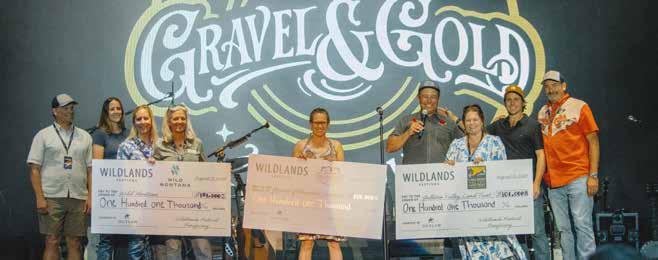

About halfway through her two-hour set, Morris told a chapter of her life story, the inspiration for her song, “Circles Around This Town.”
Morris said she moved from Arlington, Texas to Nashville, Tennessee to follow a dream which included failed tryouts on a variety of television talent competitions.
“And I remember being so thankful that they all said no to me, because it took me time for to, like, just sort of suck. And move to Nashville, learn how to write songs, figure out who I am as a person without, like, the lens of public opinion or fame... go through years of change and building something from the ground up.”
She said even when you achieve your dream, that dream keeps changing and you’ll never find the top of the mountain you’re climbing.
“Just enjoy the journey. I know that sounds so Hallmark but it’s true,” Morris said.
Her set list ranged from R&B to country to pop— including the 2018 megahit, “The Middle,” which she featured as vocalist. The crowd sang along to “My Church” and “The Bones,” and heard songs of her new EP, “Intermission,” released earlier that day.
When the halogen lights flicked on and fans cleared the arena, the music of Maren Morris echoed in their heads with three acts yet to come.
Saturday’s check presentation followed energetic performances by Nashville, Tennessee’s Side Piece and Wyatt Flores, the 23-year-old bard from Oklahoma.
Early in his set, Flores asked the audience, “How many of y’all don’t know who I am?” While quick to admit to his newcomer status, the nonetheless acclaimed country singer by the end he had won them over. Flores and his band played his hit single “Please Don’t Go” as well as several songs from his 2024 album “Half Life,” and after his second-to-last song, chants of “WYATT!” were echoing across the arena.
Flores told the crowd he’d surprised his parents with a new farm truck just two days earlier—they operate a ranch in Stillwater, Oklahoma—and said he wouldn’t have reached success without them.
“I could hang my hat tomorrow,” Flores said. “That was one of the things that I’ve always wanted to do, and I gotta say thank you to y’all because that doesn’t happen without y’all. I wish y’all could see the smile on their faces.”
There were a lot of smiling faces in the crowd as Dierks Bentley left the stage and Saturday night came to a close.
As if on cue, fat droplets of rain began to fall, giving the parched ground a much-needed drink and marking the end of the fourth-ever Wildlands Festival.
This story includes reporting by Jack Reaney.

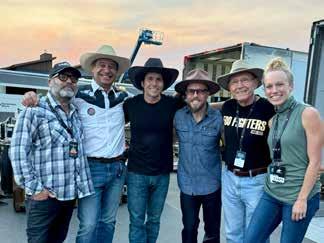







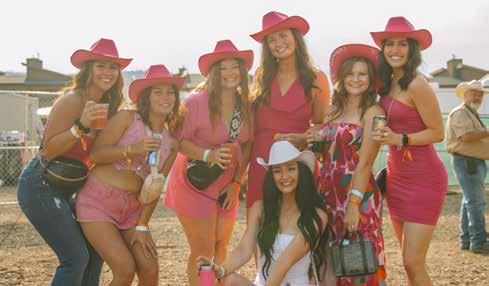










BY TAYLOR OWENS
advertisment
Located in the new Wildlands commercial units in the Northeast Neighborhood of Bozeman, Open Studio Collective has taken up residence and is offering a variety of design services to the area. Founded by Allison Bryan, a licensed architect with a passion for diverse mediums and project types, the firm seamlessly blends architecture, interiors, branding and more under one roof.
“We consider ourselves a multidisciplinary firm,” Bryan said. “We do interiors, architecture, and brand, kind of a soup-to-nuts approach, where we’d like to do storytelling through our work. We’ve done a lot of restaurants and distilleries, and we do residential, commercial, architecture, and design.”
Bryan is a multidisciplinary designer with over 24 years of experience, and her journey to founding Open Studio Collective is as diverse as the firm’s portfolio.
“I had actually been working at Nike for many years,” she said. “I was working as an architect doing global retail design, but I really wanted to get into product design. And I’d always been multidisciplinary. I went to undergrad for graphic design and graduate school for architecture. So, I’d always wanted to do multiple types of design and different mediums. But it was at Nike where I really couldn’t leave my lane. I very much had to stay in my lane.”
The birth of her daughter was a pivotal moment for Bryan. “When I left, and I left because I had my daughter and wanted to spend more time with her, I basically named it Open Studio because I wanted to be open to different technologies and mediums of design,” she explained. “So, the idea is really this, where we embrace every project and every type of project. And we take it all, we treat every product small or large the same, whether it’s a logo or a $40 million commercial building.”
Open Studio Collective prides itself on its diverse team and collaborative ethos.
“We have all types of different designers on the team, architects, interior designers, and graphic designers,” Bryan said. “It’s really about being open to project types and relationships and connecting with people.”
Sharing a space with Echo Arts, Open Studio Collective invites the community to explore both the gallery and the design office.
“This neighborhood has so much character,” Bryan said. “We love it. We love the Northeast Neighborhood and obviously the proximity to nature, but also kind of the warehouse-y feel and tight-knit neighborhood. And then the creativity piece within the neighborhood, there’s galleries everywhere. We love the activity coming out of Fink’s and Wild Crumb.”
Looking ahead, Bryan envisions deeper integration with the local community.
“We have openings all the time when new artists come in through Echo Arts,” she said. “So our doors are always open.”
Find out more about Open Studio Collective at openstudiocollective.com.









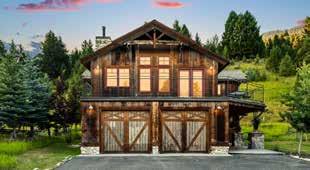



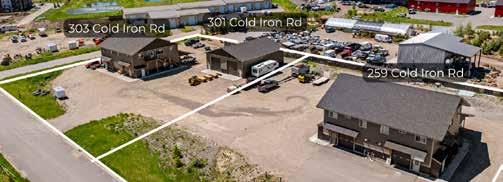
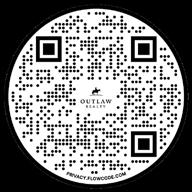



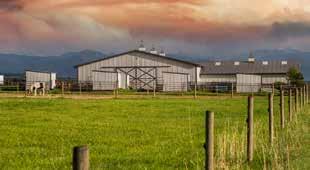








BY TAYLOR OWENS
BOZEMAN—Live From the Divide is a cornerstone of Bozeman's vibrant music scene.
Located in the Northeast Neighborhood in a century-old brick-and-wood building near the old rail yard, this historic venue sets the stage for a unique musical experience. With a limited capacity of just 50 enthusiastic audience members, the intimate space offers a unique opportunity to experience up-and-coming singer-songwriters in a location that breaks away from the norm for concerts these days.
Every month, talented artists—from national headliners, to regional gems, and local favorites— grace the small stage, creating up-close-andpersonal encounters with raw acoustics and emotional resonance. At Live From the Divide, the atmosphere transcends the conventional concert experience, bridging the gap between artists and a discerning audience.
On July 25, Early James, an Alabama singersongwriter took the Live From the Divide stage in front of a rapt audience. His music transcended the easy-to-categorize, becoming more of an amalgamation of delta, country and blues, leaving the audience stomping their feet in the rows of seating and hooting and hollering along with him.
James belted out lyrics that held humor and wit, as well as themes of darkness and strangeness. James has been known to say that even he doesn’t always know what his lyrics mean, filling his songs with interesting turns of phrase.
Live From the Divide’s small venue allowed for an up-close and personal show with James. Throughout the 80-minute performance, James frequently interacted with the crowd, asking questions and laughing with guests.
“Where do you think we go when we die,” James asked the crowd, teeing up his next song.


“We die,” and “reincarnation,” were the crowd’s consensuses.
“If we do come back, what would you want to be?” James asked.
“A bald eagle,” one crowd member said.
James then closed his eyes and started into his next song, “If Heaven is a Hotel.”
“The fact that it's a place to actually sit down and listen to what people are saying,” said Dane Andrew Thomsen, venue manager at Live From the Divide. “It's a party, but it's a very subtle party. These small 50-seat listening rooms don't really exist in a lot of places so it's a niche venue in a lot of ways and there's just not a lot of chances for these artists to come into a room like this that’s not a bar or a club and have people sit and fully give their attention for more than an hour.”
Artists such as Tyler Childers, Sturgill Simpson, Colter Wall and Charley Crockett have graced the Live From the Divide stage in years past. The opportunity to see such big names in music in such a small setting is rare if not almost impossible with the prevalence of larger concert venues.
“I've been here for 15 years and officially in 2012, I started to do ticketed shows,” said Jason Wickens, owner of Live From the Divide. “The inspiration was just being a songwriter myself and just a fan of songwriters. So I just started asking my favorite songwriters to play and to my surprise, a few of them said yes. And then, more said yes.”
From its spot in the Northeast Neighborhood, Live From the Divide has firmly found its place in the creative and artistic cultural fabric of Bozeman’s north side.
“The second I walked in [the building], I was obsessed with the history and the whole vibe of this place,” Wickens said. “I started with a commercial recording studio and then I just started booking artists to play in the front room. There was nothing in there. We would put them on the floor, set up a few speakers. This literally is grassroots, like as much as you possibly can imagine. But what's really incredible is that the community early on took to it.”
Live From the Divide has impacted the Bozeman music scene by providing a dedicated space for American Roots music and fostering a community of passionate artists and fans.
“I actually interned here 12 years ago,” Thomsen said. “That was my first job in music, and this area was the closest thing you could get to the wrong side of the tracks in Bozeman. Watching the neighborhood grow and make space for us here has been truly special.”
In the years since Thomsen’s internship, the Northeast Neighborhood has undergone significant transformation. Once considered a less desirable part of town near the railroad tracks, it has since blossomed into a dynamic area where businesses like Wild Crumb, Biome Slowcraft, Alter Cycles, Gangbusters Pottery and Beringia have taken up residence.
“Live From the Divide has been considered a hidden gem of Bozeman for so long but now the word is out,” Thomsen said. “People are coming. We get a bunch of first-timers every single show, and it's just a joy watching the community be here with us and watching it grow with us. It's a fantastic feeling that we're still here, and we're still rocking out and having a good time.”
BY TAYLOR OWENS
“I’ve been wearing and selling vintage clothing since I was 14-years-old,” Spencer Stewart, owner of Bozeman Vintage, said. “So this goes way, way back.”
Situated on N 7th Ave. in Bozeman is a small shop packed with vintage finds. Bozeman Vintage is a unique store specializing in carefully curated vintage clothing and accessories. This shop offers a nostalgic journey through history, featuring a diverse collection of items from various decades, each piece handpicked for its quality and style.
“When we started all this, we weren›t quite as Western leaning. It was about 50-50,” Stewart said. “But that really turned out to be what people were looking for. So we leaned into it much harder.”
Shoppers can find anything from classic denim, old cowboy hats, retro dresses, one-of-a-kind accessories, all reflecting the timeless charm and character of Western vintage fashion.
“We see so many people coming in, not just buying our stuff casually, but very specifically looking for types of pieces,” Stewart said. “We get such an interesting, diverse crowd looking for vintage Western wear. Everything from the real, hardcore rodeo kids, to college students, to tourists. And it's always fun when they're buying the same pieces but styling them in such different ways and looking for them for different reasons. I think we›re really the source of a lot of it.”
Vintage shops and thrift shopping have seen a resurgence in recent years, driven by a combination of sustainability, nostalgia and the desire for unique, one-of-a-kind fashion. More people are turning to second-hand stores to find quality clothing that tells a story, rather than contributing to the fast fashion cycle. The appeal of vintage lies in its authenticity and the personal connection shoppers feel with the past, as well as the opportunity to express individual style in ways that mass-produced items don't allow.
“We had the crustiest old cowboy you've ever seen, a dealer from Japan, a group of college kids on spring break, and a family from LA, all in the store at the same time,” Stewart said. “You make that Venn diagram and there's almost no crossover. And they were just all having a good old time finding stuff.”
While Bozeman Vintage has become a locale for those looking for Western vintage clothing, this clothing style isn’t necessarily historically accurate for this region of Montana.
“I think the reality of the way that people dressed in this area in that past era, is different from the way that people imagine it,” Stewart said. “So you look at



pictures of people in downtown Bozeman in the 50s, and it's suits, overcoats, fedoras. Much more just like regular street wear for that time. Not as cowboy as you'd think. But people have this idea of the American West, and we try to provide more of the idealized version than maybe what the actual reality was. We're giving people what they're looking for, but also what they expect.”
Bozeman Vintage has embraced the idealized vision of the American West, creating a style that is both nostalgic and contemporary. The shop sources items from all over, particularly from regions with a strong cowboy culture like eastern Montana and Wyoming, blending the nostalgic appeal of the past with the creative reimagination of the present. It feels like the perfect fit for the unique Bozeman vibe.
“Bozeman was pea farming, and more agricultural, and a lot of the ranching was further east,” Stewart said. “Cowboy chic versus farmer chic. We’re sourcing a lot of stuff from Billings in eastern Montana and Wyoming and really all over the country. But I think the way that we're putting it together and recontextualizing it is very Bozeman.”
The resurgence of 90s Western wear has been one of the defining trends for Bozeman Vintage. The bold prints and styles from this era resonate with both nostalgic shoppers and new generations looking for standout pieces. These items are becoming increasingly rare, making them highly sought after.
“Our biggest thing this past year is the Wrangler Brushpopper shirt, which were the brightest, most obnoxious prints of the 1990s,” Stewart said. “There’s been a real big trend in Western wear, I'd say in the past five or 10 years of it being very serious, just kind of gray. But I think people are kind of rebelling against that and really going for these bright, bright, bright colors. And we cannot find those shirts fast enough.

We cannot keep them on the shelves. They're gone before they even hit the door.”
One of the challenges Bozeman Vintage faces is finding vintage clothing that fits a wide range of body types. Unlike modern clothing, vintage pieces often come in limited sizes and unique fits, requiring extra effort to provide options for everyone.
“We try really hard to have a jeans section that suits everybody,” Stewart said. “All sizes, all fits, which isn't always easy. It's a struggle finding things that fit, especially that are vintage. But we really put in a lot of extra effort to do that. I think we've got the best boot selection, probably in the state, for vintage boots.”
Items like cowboy hats and boots are some of the most popular at Bozeman Vintage, though they often don't look the way modern customers expect. Vintage cowboy hats typically have taller crowns, and older boots come in styles that differ from contemporary designs.
“Everybody wants cowboy hats,” Stewart said. “Again, hats can be a little challenging because what they're looking for often is more of a modern style hat, so a lower crown, wider brim, and what we have are vintage hats, which are very tall, and it's just a different style. Same thing with boots. Square toe boots weren't a thing until probably 15, 20 years ago, and what we have are boots that are 40, 50, 60 years old.”
Behind Bozeman Vintage is a small warehouse full of even more pieces not out on the floor.
“Right now I've been really, really trying to find, 70s Western ski wear,” Stewart shared while pointing to several racks of brightly colored vests.
Stewart explained that he has been specifically focusing on gathering and collecting vintage Western ski vests created by Powderhorn Mountaineering, a brand established in 1972 by John Horn with the goal of introducing a new breed of ski mountaineering outerwear. These down vests were a staple of the brand with their unique leather patching and bright colors.
“I see things through a design lens. And so much of Western wear seems like it was designed without a single adult in the room. They were just like, ‘what if we made the weirdest pocket flap?’ ‘What if we added 18 belt loops to these jeans?’ ‘What if we made these boots electric orange with butterflies on them?’ Stuff is so much more experimental and just interesting, and you can sort of see what people were thinking. You can see what worked, what didn't, and what caught on. Whereas a lot of other fashion, especially vintage fashion, can be a little more safe,” Stewart said.
“I like how strange and wild it can be.”
Thursday, Aug. 8 – Wednesday, Aug. 21
If your next event falls between Aug. 22 – Sept.. 4 please submit it to explorebigsky.com/calendar-event-form by Aug. 14
THURSDAY, AUG. 8
August Show: Windows to the Wild Big Sky Artists’ Studio & Gallery, ongoing
Music in the Mountains: Doom Flamingo Len Hill Park, 6 p.m.
Live Music: Cole Decker Montage Alpenglow Lounge, 7 p.m.
MOTH After Party Tips Up, 10 p.m.
FRIDAY, AUG. 9
Bridger Brewgrass Night One Bridger Brewing (Three Forks), 7 p.m.
Live Music: 710 Ashbury Tips Up, 10 p.m.
SATURDAY, AUG. 10
Bridger Brewgrass Night Two Bridger Brewing (Three Forks), 7 p.m.
Live Music: Andy Burrows The Waypoint, 8:30 p.m.
SUNDAY, AUG. 11
St. Joseph Mass
Big Sky Chapel, 8 a.m.
All Saints in Big Sky Service Big Sky Chapel, 10 a.m.
Sunday Service Soldiers Chapel, 11 a.m.
Big Sky’s First Pinewood Derby The Waypoint, 4 p.m.
Big Sky Christian Fellowship Service Big Sky Chapel, 4:30 p.m.
MONDAY, AUG. 12
Sound Bath with Lily Santosha Wellness Center, 7:30 p.m.
Hike Big Sky: Advanced North Fork to Bear Basin North Fork Trailhead, 9 a.m.
TUESDAY, AUG. 13
Chamber Board Meeting Big Sky Chamber of Commerce, 9 a.m.
Lone Mountain Ranch Rodeo Lone Mountain Ranch, 5:30 p.m.
Line Dancing Tips Up, 7:30 p.m.
WEDNESDAY, AUG. 14
Watercolor Wednesdays BASE, 2 p.m.
Big Sky Farmers Market Big Sky Town Center, 5 p.m.
Community Art Class: Clay Runes BASE, 6 p.m.
Trivia The Waypoint, 7 p.m.
THURSDAY, AUG. 15
Music in the Mountains: Erica Falls and Vintage Soul with Jazz Cabbage Len Hill Park, 6 p.m.
SATURDAY, AUG. 17
Big Sky Biggie
Big Sky Town Center, 8 a.m.
Saturday Summer Jams: Jampoke The Waypoint, 8:30 p.m.
SUNDAY, AUG. 18
St. Joseph Mass Big Sky Chapel, 8 a.m.
All Saints in Big Sky Service Big Sky Chapel, 10 a.m.
Sunday Service Soldiers Chapel, 11 a.m.
Big Sky Christian Fellowship Service Big Sky Chapel, 4:30 p.m.
MONDAY, AUG. 19
Hike Big Sky: Advanced North Fork to Bear Basin North Fork Trailhead, 9 a.m.
Live Music: Wyatt Duo The Riverhouse BBQ & Events, 5 p.m.
TUESDAY, AUG. 20
Hike Big Sky: Intermediate Sage Creek Sage Creek Trailhead, 9 a.m.
Lone Mountain Ranch Rodeo Lone Mountain Ranch, 5:30 p.m.
Line Dancing Tips Up, 7:30 p.m.
WEDNESDAY, AUG. 21
Grief Support Group Wellness in Action, 8:30 a.m.
Dancing Down by the River The Riverhouse BBQ & Events, 5 p.m.
Big Sky Farmers Market
Big Sky Town Center, 5 p.m.
Trivia The Waypoint, 7 p.m. Do You or Someone You Know Need Help Getting Sober? Can't stop drinking? We get it. Contact AA today Call 1-833-800-8553 to talk to an AA member or go to a meeting in-person or online For a full list of meetings visit the website, aa-montana.org or download the MEETING GUIDE® APP
FEATURED: LIVE MUSIC CALENDAR
The Big Sky community and visitors can now visit an online calendar of events for any live music in the area. The calendar comes as a result of a collaboration between event venues across Big Sky, including Tips Up, Montage, Big Sky Resort, Arts Council of Big Sky, WMPAC, Riverhouse BBQ & Events, The Waypoint, and others. Find the new music calendar at bigsky.com/music.







1.
2. 3. Reserve your bear spray at heybear.com & pickup in store. Grab your Hey Bear recreation essentials. Get Outside!









BY RACHEL HERGETT EBS COLUMNIST
Almost 10 years ago, I took a December trip to visit friends in Houston. I planned to see some of the city’s vibrant art scene and the space center. River buddy Ryan Early, in typical fashion, planned for adventure.
While Texas isn’t exactly known for its outdoor recreation, especially in what Texans may consider the cold of December, we were determined to spend some time away from the city.
Our destination was Village Creek, a blackwater tributary of the Naches River running through Big Thicket National Preserve—one of the most densely forested areas in the Lone Star State.
Crystal clear creek waters provided an unimpeded view of the branches of downed trees reaching toward the surface of the creek. When I think of the trip, my mind lands first on the terror of paddling a canoe with an inexperienced—and quite drunk—co-pilot, sure that her uneven strokes in the water would eventually cause us to capsize and I would be impaled on one of those spikes. This did not happen. What stands out next is the

amazement Ryan’s friends showed at what I thought was a pretty simple camp meal.
Let’s rewind. Camp cooking for many is a no-brainer. Hamburgers and hot dogs, deli meats and cheese, chips, s’mores fixings and possibly some pre-made breakfast burritos are packed for any trip to the woods. We get comfortable in our routines.
I love a good cookout and juicy burgers fresh off the grill. I love to roast a marshmallow or a hot dog on a stick over the fire. But I also like variety and I don’t believe we have to sacrifice good food for the lack of a kitchen.
Summers in Montana have always meant multi-day river and camping trips for my family and friends. The bestprepared people in my circle keep a plastic tote stocked with camp kitchen essentials. Inside is a stove of some sort, a pan and coffee pot, dishes and utensils, knives, a can opener, salt and pepper, cooking oil and more.
I did not have such a box available for the Texas trip. I had a grill grate I had taken off of Ryan’s barbecue, a knife and an old pot. And I had the supplies we, and our thoroughly inexperienced crew, had picked up from a local Walmart. That was enough. Fresh foods often need little more than a dash of salt and pepper to be delicious, especially when smokey grill flavor is in the mix.
After digging a hole with a canoe paddle in a sandy beach beside the creek and building a fire, I threw down that grill grate and cooked the best meal those poor Texans had ever had under the stars. For an appetizer,


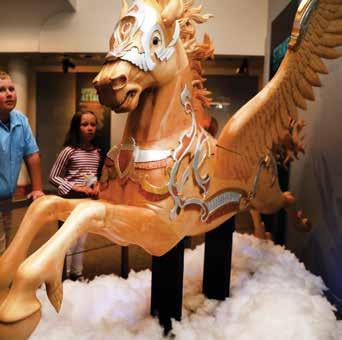



I started by stuffing jalapenos with cream cheese and wrapping them in bacon for grill poppers, for once not worrying that the bacon grease was dripping. That was followed by thick steaks with grilled zucchini and the instant version of Thanksgiving stuffing—just add boiling water. We ate well.
And you can too. If there is a trick to upping your meal game in the great outdoors, it is simply planning. Meet before the trip to decide on the meals and dole out the responsibility for cooking them. Play to individual strengths. Many of your go-to recipes can become camp favorites.
Logistically, think about what can be prepped in advance, or needs relatively little prep. Think about what can be pre-cooked. Think about the things you can grill beyond the burger, like vegetables, kebabs—hell, even fruits like peaches and watermelon. Think about what only needs a pot of boiling water and all of a sudden, your camp meals include rice pilaf or even that comforting blue box of mac and cheese.
Consider this your invitation to branch out and make your next adventure a little more flavorful. And don’t forget the salt and pepper.
Rachel Hergett is a foodie and cook from Montana. She is arts editor emeritus at the Bozeman Daily Chronicle and has written for publications such as Food Network Magazine and Montana Quarterly. Rachel is also the host of the Magic Monday Show on KGLT-FM and teaches at Montana State University.



Through January 5, 2025
Immerse yourself in the origins of legendary beings worldwide, unveiling a mesmerizing showcase of imaginative models, captivating paintings, and rich cultural artifacts. From the mythical Creatures of Water to the majestic Dragons, each section promises a breathtaking adventure. Encounter awe-inspiring, larger-than-life models like the 17-foot dragon and 10-foot unicorn.

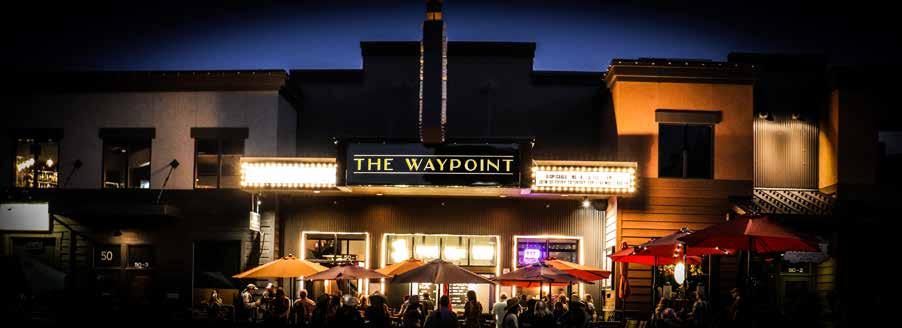







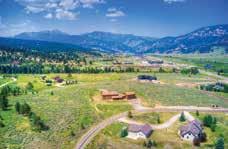
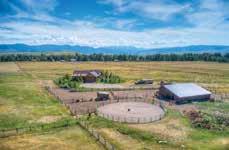

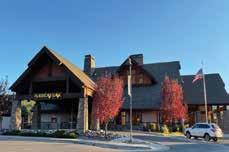
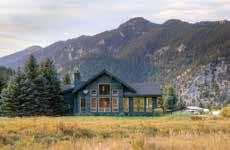





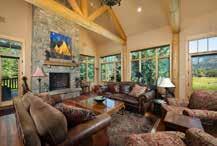
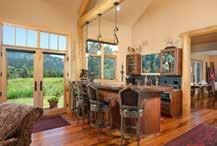





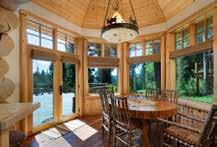

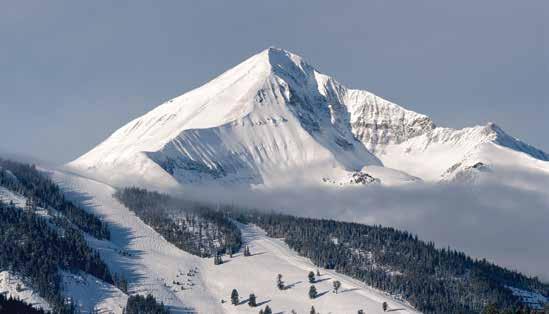








BY MICHAEL HILLIARD EBS CONTRIBUTOR
Sponsored Article
What is comprehensive investment planning?
To me, it is performing a never-ending series of x-rays for my clients. Much like a doctor’s physical, I run through a calculated list to assess my client’s financial health and measure it across the six core areas of investment planning.
Like maintaining a healthy lifestyle, it is crucial to implement a strategic investment plan and review your economic health, because a financial advisor’s job never ends, and a client’s situation never stops evolving.
Here is a generalized view of my process, the cumulative effect of which is to educate, enable, and execute strategies for my clients to be in an optimal financial position:
Financial Position – The first step is to inventory a client’s net worth and more importantly their portfolio net worth, which is exclusive of illiquid assets like home equity, vehicles, personal items, and collectibles. Next, I look at cash flow, discretionary income, and the distinct types of debt, and, yes, there is good debt (fixed, low, and tax deductible) and bad debt (revolving, high, and oppressive). It is always crucial to create a budget, and, just like making room for travel and entertainment costs, it is important to allow for systematic monthly investment and debt service. Managing your debt is just as important as managing your wealth, and net worth is the delta between accumulating a portfolio and reducing what you owe.
Insurances – Yes, you want to plan and hope for the best, but you should also insure against the worst, like a premature death, a short or long-term disability, unplanned medical costs, or a long-term nursing home stay deep into retirement. There are a couple of common truths when I speak to clients about insurances. First, everyone agrees that it is complicated, and, secondarily, most people make decisions and rarely revisit them again, which
leads to inefficiencies, gaps in coverage, and higher premium costs.
Taxes – I have never seen a more important marriage in investment planning as tax efficient investing. Are you maximizing every pre-tax opportunity with your employer-sponsored retirement plans (401k’s, 403b’s, 457’s, etc.)? Is there an employer match to your contribution, and does your company offer a Health Savings Account (HSA)? Are you participating in taxdeductible Traditional IRAs, Roth IRAs, or Roth Conversions; the latter two of which allow for tax-free accumulation and tax-free withdrawals? For your non-qualified (non-IRA) assets, and for those in very high tax brackets, are you invested in municipal bonds to avoid both state and federal taxation, while allowing for liquidity?
Investments – You cannot discuss investments without considering asset allocation and diversification. Have you diversified your portfolio by asset class, and further segmented it by investment company, type, and style in a mix of individual stocks, mutual funds, ETF’s, REITs, Unit Investment Trusts, and annuities, per your risk posture, time frames, and further tiered to your specific goals?
Retirement Planning – Here is the fun one! You have saved your entire life and now it is time to enjoy yourself and start drawing a paycheck while you’re no longer earning one. Here is where I calculate a present value analysis of your future income needs, inflation adjusted to your single or joint mortality, if married. I examine your asset base, resources, and future income streams (social security income planning is very important) to ascertain if there’s a disconnect between what you have accumulated thus far and what you should have, or how much your portfolio is returning versus how it could be performing in the many years leading up to retirement. Developing a strategic income plan and making sure your portfolio distribution rate is under 4% per year (general rule) is a major part of successful retirement planning.
Estate Planning Strategies – Someday we all will not be here, and although a depressing subject, it is also a very realistic one. I collaborate with you to help ensure your assets go to the people or organizations you wish in the most cost and
tax-efficient manner possible. I examine your beneficiary designations and utilize estate planning tools to conduct your final wishes, looking at your probate (assets passing through your will) and nonprobate (jointly owned, beneficiary) assets.
The six areas of investment planning may not be new to you, and most people have likely explored each area. However, because they share such a natural symbiotic relationship, I recommend a targeted approach in examining each subject simultaneously to improve financial success.
Michael Hilliard is a Managing Director at Shore to Summit Wealth Management. He currently works and lives in Severna Park, MD with his wife and children. Wells Fargo Advisors Financial Network is not a legal or tax advisor. Be sure to consult your own tax advisor and investment professional before taking any action that may involve tax consequences.
Wells Fargo Advisors Financial Network did not assist in the preparation of this report, and its accuracy and completeness are not guaranteed. The opinions expressed in this report are those of the author(s) and are not necessarily those of Wells Fargo Advisors Financial Network or its affiliates. The material has been prepared or is distributed solely for information purposes and is not a solicitation or an offer to buy any security or instrument or to participate in any trading strategy Wells Fargo Advisors Financial Network and Shore to Summit Wealth Management are not legal or tax advisors. You should consult with your attorney, accountant and/or estate planner before taking any action.
Shore to Summit Wealth Management is located at 105 E. Oak Street, Unit 1A Bozeman, MT 59715 # 406219-2900.
This advertisement was written by Wells Fargo Advisors Financial Network and provided to you by Michael Hilliard, Managing Director.
Investment products and services are offered through Wells Fargo Advisors Financial Network, LLC (WFAFN), Member SIPC. Shore to Summit Wealth Management is a separate entity from WFAFN.
©2023 – 2024 Wells Fargo Advisors Financial Network, LLC. All rights reserved.
Big Sky Land Management was founded back when Big Sky was facing the devastating affects of pine beetles. Motivated by maintaining a healthy, wildfire-safe landscape, owners Danielle and Justin Miller grew what was once Big Sky Fire Prevention in 2005, into a large-scale excavation, building and utility installation company—they’ll handle everything outside except the landscaping in residential homes across Big Sky.
With a following of 46,000 on their Instagram page, Danielle and Justin are also brand ambassadors for Caterpillar, traveling around the country, and soon-to-be-world, to attend events on behalf of Caterpillar. “It’s an amazing opportunity and we are very grateful to be part of the Caterpillar team,” Danielle said of the partnership. Explore Big Sky spoke with Danielle about working in Big Sky and with Big Sky residents, and the challenges they’re facing gracefully as the area grows.
This series is part of a paid partnership with the Big Sky Chamber of Commerce. The following answers have been edited for brevity.
Explore Big Sky: Danielle, first tell me a little bit about yourself—what brought you to Big Sky?
Danielle Miller: Skiing and college. I was looking for a college close to a ski mountain and found Big Sky. During college, I met Justin and we moved in together three months later. I lived in Big Sky and commuted to Montana State University for three years while finishing my degree. After college I worked at the Big Sky Chamber for two-and-a-half years and left to help Justin grow Big Sky Land Management, which at the time was Big Sky Fire Prevention. That was 2015 and first day on the job we hired three more employees. Over the last nine years we have grown to 33 employees.
EBS: When did you and Justin decide to start BSLM? Did you see a need in the community?
DM: Justin started our business in 2005 while Big Sky was facing a devastating infestation of Pine Beetles. The pine beetle targeted Lodge Pole Pine trees and the trees started dying off in massive sections around Big Sky. Justin picked up a chainsaw and started helping landowners safely remove dead, dying and diseased trees. In
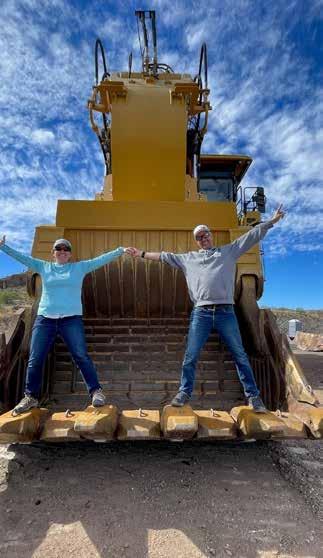
2012 we expanded our services to excavation to help fill the growing need of development in our community.
EBS: What has changed most in your industry since your founding, and how have you adapted to that change?
DM: Our biggest struggle is educating landowners about their forest and their land. We are constantly challenged to find more cost-effective ways to effectively remove trees. Thus, we have transitioned to using equipment including tracked mulchers and masticators. This has greatly reduced the time and cost to selectively thin large acres. Expanding our services to excavation also helped us provide more services so we can build driveways, trails and help build more homes.
EBS: For those unfamiliar, what kind of services do you offer and what is your most in demand in the area?
DM: We started as a forestry company and have expanded in excavation services. We specialize in excavating foundations, building driveways and installing utilities for custom, high-end, residential homes. We handle everything exterior of a home except for landscaping. We continue to provide forestry services and specifically thinning and fuel reduction for landowners in Montana.
EBS: What would you say sets you apart from other competitors?
DM: Being reliable, honest and nice. Justin is probably the nicest guy in town and knows almost everyone. His integrity and willingness to provide solutions has helped us grow to where we are today. We’ve hired people who hold similar values and thus have built a team of amazing people who are motivated to do a good job.
EBS: What do you love most about working with the people, businesses and homeowners of Big Sky?
DM: The challenge. Every property is different, and each owner has different wants and needs. The principals are the same, but we enjoy the challenge of making it unique for the homeowner. Sometimes this involves getting very creative and resourceful to complete projects. As Big Sky grows this is going to become more and more challenging as all the easy lots have been developed.
EBS: Where can we find you when you’re not at work?
DM: Next week, we’ll be at the farmers market and music in the mountains. On the weekends we’ll either be on the lake or river and in winter on the ski mountain or snowmobiling up Buck Ridge. Our philosophy is work hard, play hard.
EBS: What is some business advice you’ve received that has stuck with you?
DM: Understand your finances. When your business cash flows, it opens so much opportunity to make a business great including hiring great people and giving back to your community.
EBS: Anything else you’d like to tell the Big Sky community?
DM: No one is going to stop Big Sky from developing … but we can work together to grow sustainably and find solutions to common problems. We have amazing people in our community who help make Big Sky great by volunteering. Stay in touch and join our 45,000 followers on Instagram @Bigskylandmgmt.

BY PETER GARTRELL WRITERS ON THE RANGE
The coal mining industry reacted with outrage when the Bureau of Land Management recently announced plans to stop issuing new coal leases on the eastern plains of Wyoming and Montana.
From its headquarters in Washington, D.C., the National Mining Association predicted “a severe economic blow to mining states and communities,” while the industry’s political allies likened the move to declaring “war” on coal communities.
The truth is that coal has been steadily falling from its past dominance as energy king for nearly two decades. Domestic coal consumption dropped to 512 million tons in 2022, down 55% since its 2007 peak.
With the downward trajectory expected to continue, the Biden administration’s decision to end coal leasing in the Powder River Basin—the nation’s largest coal-producing region—reflects clear market trends. And far from killing coal, the administration’s plan allows mining to continue as the market transitions.
Billions of tons of previously leased federal coal remain available for mining from 270 tracts across the nation, which combined cover an area larger than Rocky Mountain National Park. One Montana mine has enough coal to keep operating until 2060. Taken together, economic effects related to ending new coal leasing in the Powder River Basin may not be felt until the 2040s and beyond.
Coal companies are well aware that U.S. energy markets have rapidly changed, a fact they soberly tell investors: “Over the last few years, customers have shifted to long-term supply agreements with shorter durations, driven by the reduced utilization of [coal] plants and plant retirements, fluidity of natural gas pricing and the increased use of renewable energy sources,” Wyoming’s largest coal producer, Peabody Energy, disclosed in its 2023 financial filing.
Even with declining markets, the Biden administration did not come to the decision on its own. Arguing that BLM’s past reviews of coal’s contributions to climate change were inadequate, a coalition of environmental groups sued the government and won. That forced the agency to revisit whether more coal leasing was warranted.
“For decades, mining has affected public health, our local land, air, and water, and the global climate,” said Lynne Huskinson, a retired coal miner. She’s a member of the Powder River Basin Resource Council, a Wyoming landowners’ group that was among the plaintiffs.
Now, she said, “we look forward to BLM working with state and local partners to ensure a just economic transition for the Powder River Basin as we move toward a clean energy future.”
Huskinson lives in Gillette, Wyoming, where a dozen highly mechanized strip mines sprawl across the grasslands of the Powder River Basin. The Wyoming mines alone produce 40% of U.S. coal while employing less than 10% of the nation’s 44,000 coal workers.
The Basin’s mines have leased 8 billion tons of federal coal since the 1990s, a cheap and plentiful supply for the industry. The leasing process allows companies to nominate desired tracts, and then
bid with little or no competition. Winning bidders often pay less than $1 a ton for coal, plus a nominal annual rent and a royalty after final sale.
There is little question that leasing helped launch and sustain the region’s energy boom. But in his 2022 decision, Judge Brian Morris of the Federal District Court of Montana cast his eye toward the future. Morris wrote that federal law required BLM to consider “long-term needs of future generations” that included “recreation, range, timber, minerals, watershed, wildlife and fish, and natural scenic, scientific, and historical values.”
The judge also gave the federal agency an out: “Coal mining represents a potentially allowable use of public lands, but BLM is not required to lease public lands.”
Morris’ words cleared the way for BLM to stop leasing, a decision that dovetails with a Colorado College poll that found most residents in eight Rocky Mountain states—including Wyoming and Montana—want Congress to prioritize conservation over energy development on public lands.
The legal wrangling will likely continue, with the BLM reviewing protests from the coal industry and its political allies that lay the groundwork for more lawsuits. For now, though, it seems the Biden administration’s decision to keep coal in the ground not only follows the market and the law, but public opinion, too.
Peter Gartrell is a contributor to Writers on the Range, writersontherange.org, an independent nonprofit dedicated to spurring lively conversation about the West. He is a consultant in Washington, D.C., and covered coal leasing issues as a journalist and congressional staffer.


BY BENJAMIN ALVA POLLEY EBS COLUMNIST
On July 25, a relatively quiet summer day with a hint of smoke in the air from all the forest fires, a dam was blown to smithereens deep in the Rattlesnake Wilderness. The boom could be felt and heard for miles. The explosion’s plume rose hundreds of feet while rock shrapnel flew in many directions. The debate about Wilderness and the technicalities in language has been brewing since its inception but renewed in some circles this past year.
Last November, Lolo National Forest Supervisor Carolyn Upton approved limited motorized equipment and mechanical transport use and limited helicopter and vehicle access to decommission the earth and timber dam—even though the 1964 Wilderness Act prohibits using mechanical or motorized equipment unless it was grandfathered in when the wilderness was designated, or the U.S. Forest Service grants a waiver. The Act, passed to protect and preserve the country’s wilderness areas, allows for certain exceptions under specific circumstances such as this.
Upton allowed the use of mechanical equipment because mechanical equipment and the dams were grandfathered in. The city of Missoula, Mountain Water, and the Montana Power Company—the previous water-rights owners—routinely flew annual maintenance flights into the eight lakes and 10 dams and drove motorized vehicles on the gravel road into the Wilderness.
“I am limiting helicopter use to one day to bring in equipment and supplies for the expected 12–13week work window and one day to remove the equipment and supplies,” Upton wrote in an email to the Missoula Current. “This avoids the negative impacts that approximately 48 pack train trips (round-trip) would have on the trail and work area and enables the work to be completed in one field season.”
Other mechanical or motorized activities for the project include driving the single-lane gravel road leading to the boundary biweekly to drop off work crews, using a motorized dewatering pump at the breach site, using a power auger to drill holes for blast charges, and moving rocks using wheelbarrows and carts.
Most people were in favor of the dam removal. However, some wilderness purists were riled over the process and the means used for the removal. These groups argue that the gear to get the work crews into the Wilderness and the dam’s remains should be packed out by horseback and no motorized or mechanized tools should be allowed.
The alternative would mean dozens of mule pack strings carrying gear in and out of the wilderness, nearly 15 miles each way. Work crews would also

have to hand-pump water out of the breach site, hand-drill holes with non-motorized augers into the earthen dam and carry all fill material by hand or on the backs of mules.
The National Wilderness Preservation System defines wilderness as areas “where the earth and its community of life are untrammeled by man.” These areas are untouched by most forms of development and motorized vehicles.
Wilderness Watch, a Missoula-based organization, liked the idea of dam removal but didn’t support using mechanized or motorized equipment because it violates the concept of wilderness that must be untrammeled. Wilderness Watch conservation director Kevin Proescholdt was disappointed with the USFS decision.
“The Forest Service authorized helicopter and motor-vehicle use up to the dam. Unfortunately, it seems the Forest Service chose expediency over wilderness values,” Proescholdt stated in an email to the Missoula Current.
The Rattlesnake Wilderness, north of Missoula, has 10 storage dams on eight lakes. The Montana Power Company built the dams between 1911 and 1923 as a city’s backup water source. A century ago, the dams were crucial to managing the city’s water. Thus, when the Rattlesnake Wilderness was designated as wilderness in 1980, certain maintenance activities were grandfathered. In 1979, they sold the dams and the water rights to Mountain Water Company. However, after a giardia outbreak in 1983, the MWC transitioned to well water, leaving the lakes as backup water. The City of Missoula now operates the wilderness dams under a special use permit with Lolo National Forest after buying the rights from MWC.
The McKinley Lake Dam, constructed in 1923, is an earthen dam with a crest width and height around 15 feet, and a maximum storage capacity of 211 acre-feet. The dam was composed of rock piles, and the removal is a point of contention among wilderness groups. This dam was the first to be decommissioned and blown to smithereens.
According to Missoula Water’s 2018 Rattlesnake Dams Feasibility Study, the dam was outdated and needed to be removed. It was classified as a “Significant” hazard, which means that its failure for any reason wouldn’t endanger human life
but could cause non-recoverable environmental damage. A breach failure could result in erosion and sediment transfer to Lake Creek and ultimately to Rattlesnake Creek, which hosts bull trout, a threatened species.
The dams are no longer necessary, but the USFS must maintain them. They need repair, and the city must keep the road leading to them in good shape. The dams either need to be repaired or decommissioned. The feasibility study estimated that the rehabilitation of the dams would cost $7 million for all 10 dams versus just $1.2 million to decommission them. Eliminating them makes economic sense and paves the way for a more sustainable and cost-effective solution.
After extensive public outreach and meticulous planning, the city of Missoula has initiated the dam’s decommissioning in collaboration with project partners Trout Unlimited, Montana Fish, Wildlife and Parks, and the U.S. Forest Service. This work involves a series of steps and requires careful execution.
First, removal of the dam spillway, embankment, and adjacent apron for nearly 100 feet along the top of the dam. The second is removing piping, outlet valves, and other control structures. Third, the natural material from the earthen dam will be repurposed as fill, lining the lake edges. Finally, the dam’s gravel, cobble, and boulders will be used for the project’s stream construction portions, ensuring minimal environmental impact. However, it’s important to note that even with these precautions, the removal process may still cause some disruption to the local ecosystem, particularly in terms of noise pollution and disturbance to wildlife habitats, which is a concern for some wilderness groups.
Trout Unlimited, FWP, and the Forest Service are deeply committed to removing some of the nolonger-necessary dams that hinder trout migration to some of Rattlesnake Creek’s headwaters. Their dedication not only preserves the wilderness character of this place but also restores the natural habitat and eliminates signs and impacts of modern humans.
The proper steps in this situation are not always black and white. Howard Zahniser, the writer of the Wilderness Act, probably knew that people in the future would wrestle with what the wilderness character meant and that answers ahead wouldn’t always be evident. In this case, opening up motorized or mechanized tools in the wilderness can be slippery, especially when and where not to allow it.
Benjamin Alva Polley is a seasoned place-based storyteller with a profound passion for environmental conservation. His stories are published in Audubon, Esquire, Field & Stream, The Guardian US, Outside, Popular Science, and Sierra, with a master’s in Environmental Science and Natural Resource Journalism from the University of Montana and extensive field experience, including two seasons in Montana’s Bob Marshall Wilderness area, one in California’s Trinity-Alps Wilderness, and 13 years in Glacier National Park.


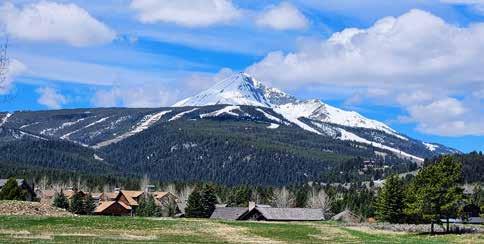






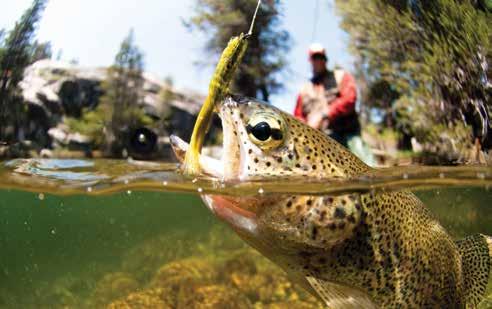

















Beautifully designed condos and penthouses in an incredible, highly sought-after location. Footsteps away from Big Sky Town Center restaurants, shopping, farmers markets, live music, and all that Big Sky has to offer. A downtown lifestyle where rooms are filled with natural light and breathtaking views no matter the time of day or the season. 3rd level penthouses come with private, 4th-level rooftop decks. Relax in your hot tub and let the stargazing begin.
• Exquisite engineered hardwood floors
• Meticulously crafted cabinets
• Luxurious granite countertops
• State-of-the-art stainless steel Ge monogram appliances.
• All residents have a storage unit in addition to their residence.
• All residences have a designated & secure parking space. Additional parking spaces are for sale.
• 3rd level penthouses come with private, 4th-level rooftop decks.
www.thefranklinbigsky.com

BY ANDY NAGEL EBS COLUMNIST
Adulting has been the main theme of my summer so far, and I haven't been accessing my outlets as much as I'd like. Reflecting on what I envisioned for my 2024 summer, I saw lots of mountain biking, weekend backpack trips, kayaking, golfing, photography and fishing. Experiencing those visions fueled my stoke levels.
Unfortunately, by mid-July, I wasn't getting after it as much as I'd like, or at all. One day, I began to ruminate on a wasted summer, time I'd never get back because I'm getting older, opportunities missed, skills I'd never gain, my weaknesses, the unknowns and what-ifs, and a lot more.
"I blew it, summer feels like it's over," I said to myself. My anxiety felt like it was inching toward overdrive, and a downward spiral was imminent. I began to recognize my catastrophizing thoughts and used cognitive behavioral therapy to put them at bay.
Although I'm still immersed in a copious amount of adulting and not really getting after it, I've been able to maintain a regulated central nervous system, embrace the reality of it all, go with the flow, be happy and choose joy.
How is your summer going? Is it going exactly the way you envisioned? If your answer is no, rest assured—you are not alone. Every time I voice this struggle to those in my bubble, we discover our commonalities in navigating this struggle. Discovering I'm not the only person enduring this challenge has brought some peace of mind. Many people go through this every season, and everyone handles it differently. Leaning into your support network is a great start to moving in the direction of a joyful summer.
Experiencing challenges that cause us to deviate from our intended path is normal in navigating human experiences. Unfortunately, life isn't easy. As we flow from one season to the next, what happens when we're faced with unexpected challenges? Especially challenges that drag out for days, weeks or months? Are we equipped with proper tools and thought processes to endure and overcome? Or do we isolate and criticize ourselves, dwell on the past, and embody “I’m over it” as a personal motto? It's ok to not be ok. However, settling into less-thanideal situations and patterns of thoughts is not. Have you found yourself giving up on summer? If so, let's identify and deal with those thoughts. Proper preparation and consistent practice for when this happens can help prevent downward spirals.
When outcomes we hope for don't match results, we're often very critical of ourselves and the situation in a way that doesn't match reality. I've let the walls come down around me while attaining skills and experience that require error and failing forward to improve. Have you ever called yourself an idiot for not knowing how to do something? Or ruled yourself incapable after trying something new, and not being good at it the first time? This is called catastrophizing, a cognitive distortion that involves exaggerating difficulties or believing a situation is worse than it is, or imagining the worst possible outcome of an action or event. Identifying catastrophizing is the first step to prevent it from getting worse.
My favorite tool to deal with catastrophizing is cognitive behavioral therapy. CBT helps people gain control over their thoughts, feelings and behaviors by identifying and challenging unhelpful thoughts, and replacing them with more realistic and positive ones. I was introduced to CBT and catastrophizing while enrolled in the Department of Veterans Affairs' 30-day residential treatment program. My circle of vets and I held each other accountable for catastrophizing with a simple statement: "CBT those thoughts!"
You do not have to seek a medical professional or system to access cognitive behavioral therapy. Start by looking it up online, in bookstores and libraries. Start the conversation by asking others if they know about CBT. Utilizing CBT on a daily basis aids in skillful in-the-moment responses.
Recognizing catastrophizing, and utilizing CBT also aids in maintaining a regulated central nervous system. Your CNS is best when it's regulated and at rest. It yields a better version of yourself—that centered you that's in the zone, keeping things cruisy and chill as you navigate one moment to the next. It's important to tune in with your CNS. Besides cognitive behavioral therapy, many other tools are available to deal with catastrophizing. They include breathing exercises, vagal toning, charts methodically placed in locations to remind ourselves to check in and positive affirmations.
So if you think you're totally blowing it this summer, and are ready to give up on your season, before you say you're “over it,” consider that you might be catastrophizing. If so, then I recommend you CBT those thoughts. Remind yourself of what you have accomplished this season.
You are still here! That is an accomplishment. The exact halfway point of summer is 12 p.m. on Aug. 1 according to the lunar calendar—we're barely halfway through. There's plenty of time to experience the joys you yearn for. Take it one moment at a time, along with some deep breaths, and remember that you're the one who's in control of your thoughts.
Andy Nagel works at Big Sky Resort. Around the community he volunteers as a Wellness Navigator, leads Holistic Emotional First Aid sessions, and is an active member of the Be Well Big Sky Leadership Council.


BY KALEY BURNS EBS COLUMNIST
Hormones are critical for nearly every essential function of your body. They are the messengers that tell your cells what to do, and regulate vital sensations such as mood and energy.
Hormones are chemicals made by the endocrine glands. They tell other parts of your body how and when to function. Even the slightest imbalance can cause symptoms that disrupt overall health and daily life.
Holistic hormone replacement therapy can be used as a treatment for these symptoms. Bioidentical hormone replacement therapy helps to support and balance your hormones as you go through various stages and shifts in life. BHRT is a natural hormone replacement strategy that uses hormones derived from plants to mimic those produced by the human body. Meanwhile, synthetic hormones used in hormone replacement therapy do not have the same molecular structure as the hormones in your
body. Instead, your body has to work to break them down into a usable form.
Ultimately, the research has shown that bioidentical hormones are associated with lower risks, including the risk of breast cancer and cardiovascular disease, and are more effective than their synthetic and animal-derived counterparts.
We can also support hormone health naturally through balancing the diet, addressing digestive health and function of the liver. The liver is a very important organ. It metabolizes proteins and carbohydrates, stores nutrients, synthesizes cholesterol, neutralizes toxins and processes hormones. A healthy liver can excrete excess estrogen and keep hormones in balance. However, a stressed or overworked liver leads to elevated estrogen and hormonal imbalance.
Chronic stress can have a negative impact on your hormone levels, making stress management equally important. When the body is under stress, the adrenal glands produce cortisol. In times of excessive stress, the body will convert progesterone to cortisol to preserve heart and brain function. As a result, chronic stress can deplete progesterone and can lead to estrogen dominance.
Hormone testing is not common practice in conventional medicine, but helpful nonetheless. Similarly, many patients are told that their labs are “within normal range,” yet they still experience symptoms. Every patient has their own unique biochemistry, genetics and health conditions, which often means a broader spectrum of testing can prove beneficial. Specialty labs serve to narrow down where therapy must be applied to bring back balance to one’s health.
Holistic management of hormone care is beneficial at all phases of life. Things like nutrient deficiencies, a lack of sleep and high amounts of emotional stress can all disturb hormonal balance and raise inflammation. A holistic healthcare team can help optimize your hormone balance.
Dr. Kaley Burns is a licensed Naturopathic Physician providing a wide range of services for her clients, including: Naturopathic Medicine, IV Nutrient Therapy, Regenerative Injections, Rejuvenation Therapies, Vitamin Shots, and Nutrition Counseling. She embraces a natural approach to health and aims to similarly inspire and guide others on their health journey.




ROBB WOLF EBS COLUMNIST
Many sources advise drinking beyond thirst, but that advice can do more harm than good. Drinking too much plain water can dilute blood sodium levels, which can cause headaches, fatigue, confusion, and worse. This is common in endurance athletes, but anyone can over-hydrate if they’re ignoring their body’s signals and drinking more than they need. It’s especially something to be aware of in the hot summer months or similar extreme conditions.
I have an aversion to alarmist content, but I think it’s important to talk about this stuff. The truth is, overhydration has generally proven to be more dangerous than dehydration. And it can be hard to discern between the two because the symptoms can be quite similar, which makes it extra important to hydrate smartly.
If you take nothing else away from this article—or simply have someplace else to be—the main takeaway to hydrate safely is to drink electrolyte water to thirst. This will simultaneously prevent overhydration and dehydration.
If you’re sticking around for a while, we’re going to debunk bad hydration advice, share the symptoms of overhydration to look out for, and then explore how to prevent and treat it. Ready to get to it? Let’s dive in.
Bad hydration advice
The problem of overhydration is rooted in decades-old health recommendations. In the 1940s, the U.S. National Academy of Sciences started telling people to drink 84 ounces of water per day. About twenty years later, a physician named Irwin Stillman recommended a weight loss diet that included eight glasses of water daily.
Neither recommendation had any science behind it, but the “more water is healthier” meme stuck like a bad political slogan. Consequently, many people believe healthy hydration is synonymous with preventing dehydration at all costs.
Sites and resources touting the inaccurate hydration advice are still rampant today. In a 2016 paper, researchers used common Google searches— “hydration guidelines,” “drinking fluids,” etc.—to uncover 141 hydration-related websites. Over one-quarter of the sites were related to scientific organizations, peer-reviewed literature, or medical professionals, but nonetheless they dished out impractical advice. Here are the two most egregious bits.
Bad hydration advice #1: Drink beyond thirst to stay hydrated
What the science actually says: Drink to thirst to stay hydrated. Our thirst mechanism has been finely tuned over millions of years. When we need water, we get thirsty. When we’re hydrated, we’re not thirsty. For most folks, it really is as simple as that.
The science: Thirst is controlled by a region of the brain called the hypothalamus. This brain region is sensitive to receptors that are perpetually monitoring your blood volume, triggering thirst if blood volume gets too low from, say, heavy sweating.
The problem with drinking plain water beyond thirst is that excess plain water dilutes blood sodium levels. As sodium levels fall, confusion, brain fog, weakness, and other neurological symptoms can occur.
Exercising is one of the most common scenarios where folks might overhydrate. It can be a tricky situation because exercise increases levels of antidiuretic hormone, making it harder to excrete excess fluids through urine while being active. Too much water coming in and not enough going out—that’s a recipe for overhydration.
The standard advice when it comes to hydrating during exercise is to drink water to replace weight loss (only 7.3%
of relevant websites advised drinking to thirst to hydrate for exercise). Weight loss is supposed to be an accurate proxy for water loss (dehydration), but unfortunately, it’s not. One study found that runners lost 5.5 pounds during a 56 km race, but total body water only dropped about 3 pounds. This suggests your body loses weight from non-water sources (like body fat) during exercise. It also suggests that drinking to replace weight loss replaces too much water.
In a perfect world, you’d replace sweat losses 1:1 with a mixture of water and salt, the main constituents of sweat. That way, sodium levels would stay stable during fluid replacement. You can calculate your fluid and sodium losses through sweat if you want to be precise (read our guides to sweat rate and sweat sodium concentration), but listening to the body and drinking salty fluids to thirst works just as well for many in our community. Adding about 1 gram of sodium per liter (32 ounces) of water is a reasonable estimate to replace the sodium lost through sweat.
To recap, whether you’re exercising or just looking to hydrate smartly: Listen to your body. Drinking to thirst (and including electrolytes in your water) prevents the dangers of overhydration and dehydration simultaneously.
Bad hydration advice #2: Drink extra water during exercise to prevent heat illness
What the science actually says: Dehydration can contribute to heat illness, but drinking excess water won’t prevent it. Heat illness during exercise can occur with or without dehydration.
The science: Only 3.4% of hydration websites correctly identified that dehydration is “not generally a cause of heat illness during exercise.” Although dehydration does reduce sweat rate and therefore your ability to cool yourself, non-dehydrated athletes often develop heat illness nonetheless. Proper hydration doesn’t protect you from heat illness if it’s hot enough and the exercise is intense enough.
For example, one study found that dehydrated athletes stopped exercising at lower core body temperatures than hydrated controls during hot, intense exercise sessions. In other words, dehydrated athletes stayed further away from heat exhaustion and heatstroke, which are defined by elevated body temperature.
This finding doesn’t mean you should seek out dehydration during physical activity. Again, dehydration can impair your ability to stay cool. But it does suggest dehydration isn’t the primary cause of heat illness during exercise. More likely causes include the environment (temperature, humidity, breeze), exercise duration and exercise intensity.
Beyond exercise, most cases of heat illness occur in babies or seniors. Why? Because these populations have less functional sweat mechanisms, regardless of hydration status.
A final point? The focus on avoiding dehydration to prevent heat illness often leads to overhydration, which can mimic dehydration symptoms. This confusion occasionally has tragic consequences.
Again, the key here is to drink to thirst, and adding in electrolytes can help replace sodium sweat losses plus prevent overhydration. And the most effective heat illness preventative is staying out of the heat.
Now that we’ve debunked some common hydration myths let’s cover the symptoms of overhydration so you know what to watch for.
Overhydration symptoms
When I talk about the symptoms of overhydration, I’m talking about the symptoms of low blood sodium levels,
medically known as hyponatremia. These symptoms fall into two buckets: mild and severe.
Mild cases may resolve without medical treatment, but many cases require the help of health professionals. Seek medical advice if you’re not sure.
Mild to moderate overhydration symptoms
The early symptoms of hyponatremia include dizziness, fatigue, muscle cramps, mild nausea, and bloating. As the condition worsens, the hyponatremic person may also experience headaches, confusion, irritability, light sensitivity, vomiting, drowsiness, difficulty breathing and altered cognition.
These symptoms are common in distance athletes who over-hydrate with plain water, but various medical conditions (like heart or kidney issues), illnesses that cause vomiting or diarrhea, and drugs (like diuretics or NSAIDs) are also risk factors.
Severe overhydration symptoms
Severe overhydration symptoms include seizures, coma, abnormal posturing (a sign of brain damage), and dilated pupils.
In these cases, seek immediate medical attention. Urgent treatment with IV hypertonic saline fluids (saltwater) can help prevent brain damage or death.
Preventing and treating overhydration
So there you have it: More water is not always better. To recap, here are the practical takeaways for preventing overhydration.
Drink to thirst. Drinking to thirst prevents both overhydration and dehydration. Your body knows when to stop consuming fluids. Tune in to it.
Don’t drink to replace weight loss. Not all weight lost during exercise is water weight. You’ll likely over-hydrate if you replace every pound you lose with plain water.
Don’t expect water to keep you cool. Drinking extra water doesn’t prevent heat illness. Staying out of the heat does.
Put salt in your water. Sip salty fluids to thirst throughout the day to prevent dehydration and low sodium. Athletes lose about 1 gram of sodium per hour of sweaty activities. That’s one of the reasons there’s 1 gram of sodium in each stick pack of LMNT Drink Mix and can of LMNT Sparkling.
In terms of treatment, it’s always best to consult a medical professional. There are three main treatments:
First, restricting sodium-free fluids. This “stops the bleeding,” metaphorically speaking. When you cut off plain fluids, your body can excrete excess water to normalize sodium levels.
Second, administering intravenous (IV) saline. This is the default medical intervention. Medical professionals typically administer an IV solution containing 3% NaCl (salt), or about 1.2 grams of sodium per 100 mL of fluid.
Finally, drinking salty water. There’s some controversy over oral saline (saline = salt water) vs. IV saline for treating hyponatremia, but research suggests it’s a viable alternative in some instances. In one trial, oral saline was as effective as IV saline for reversing hyponatremia in runners after a 161-km race. It’s best to let a medical professional dictate hyponatremia treatment, though.
All right then, we’ve just replaced inaccurate hydration advice with science-backed knowledge. If you forget some of the hairy details, that’s okay. Just remember the fundamental rule of hydration: drink salty fluids to thirst.
Robb Wolf is an LMNT athlete. This column has been published with permission from LMNT.







Located on the Middle Fork in the Meadow Village, this special setting offers exclusive privacy with recreational open space on two sides. Enjoy convenience in the centrally located, low density Silver Bow complex which boasts mature landscaping, a community outdoor swimming pool and a large indoor hot tub. Being an end unit on the ground floor, this condo affords easy access to the outdoors. $725,000 #393448
KIRK DIGE 406-580-5475

Welcome to your dream retreat in the heart of Big Sky, Montana! For the very first time, this exquisite custom home, nestled amidst the breathtaking landscapes, is now available for purchase. Perched elegantly overlooking the majestic Lone Peak Mountain, this remarkable residence showcases unparalleled craftsmanship and timeless elegance. $4,998,900 #392748
DAN DELZER 406-580-4326







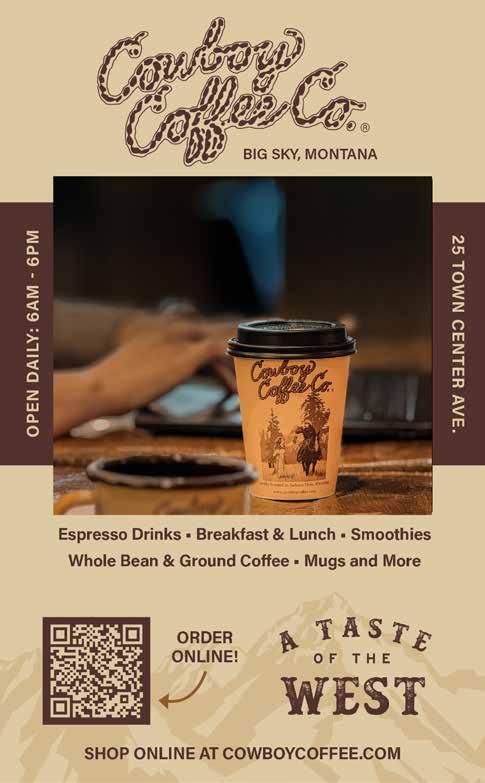
Guided by a seasoned veteran with nearly two decades of experience, SAV is committed to crafting unforgettable experiences for our clients. Our team, comprised of individuals who are deeply passionate about client service, work tirelessly to ensure that each interaction leaves a lasting & positive impression.



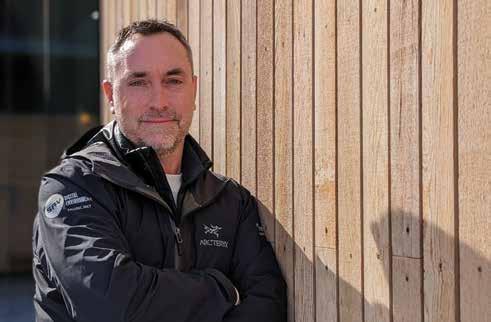

“SAV is built upon a foundation of experience & unmatched industry knowledge. We believe each of us needs a sense of pride & satisfaction to be the best.”



Ryan Coombs Operations Director

















Seamlessly
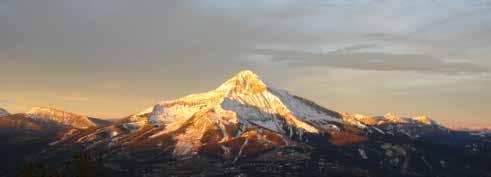

$2,600,000 | #388104

$1,750,000 | #389834

$1,600,000 | #380146

TBD TIMBERLOFT DRIVE
Big Sky
40± acre alpine meadow overlooking the Gallatin Canyon, outstanding views of the Spanish Peaks and Lone Mountain. Two adjacent 40± acre properties, designated building sites, end of the road privacy easy all season access. Close to Ophir School and the West Gallatin River.
TBD SKYWOOD ROAD
Big Sky
Enjoy privacy and outstanding views of Lone Peak from this beautiful Skywood Preserve property. Rolling forested hills combined with a grassy alpine meadow complete with a small natural pond create a beautiful 21± acre parcel, just minutes from Town Center or Meadow Village.
TBD LOW DOG ROAD
Big Sky Ski accessable w/ biking and hiking access to area trails. Convenient to all the services at Big Sky’s Mountain Village. Great access to the Middle Fork of the Gallatin River by taking an established trail from the building site directly to the stream. Property located on the North side of Low Dog Rd.

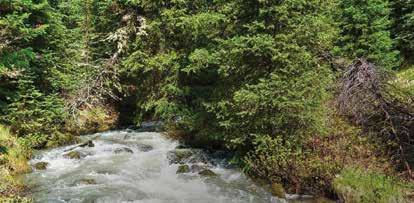



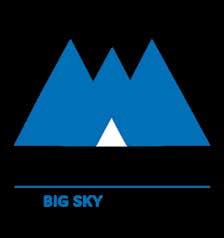
LEARN HOW BIG SKY WORKS DEVELOP LEADERSHIP SKILLS NETWORK WITH LOCAL LEADERS
Leadership Big Sky is an 8-month long program designed to engage and empower emerging leaders in our region.
There is nothing standard about doing Business in Big Sky – it is up to the hard work and creativity of our special districts, nonprofits, an d dedicated local business leaders to make our community the success that it is.
Cost is $1,200 for Chamber Member businesses. *Scholarships available for Nonprofit and Small Business Chamber Members.
For more information, application, and programming


TIMELINE
Applications Open | Thursday, August 1st
Application Closes | Friday, September 13th
Applicants Selected and Informed | Friday, September 20th
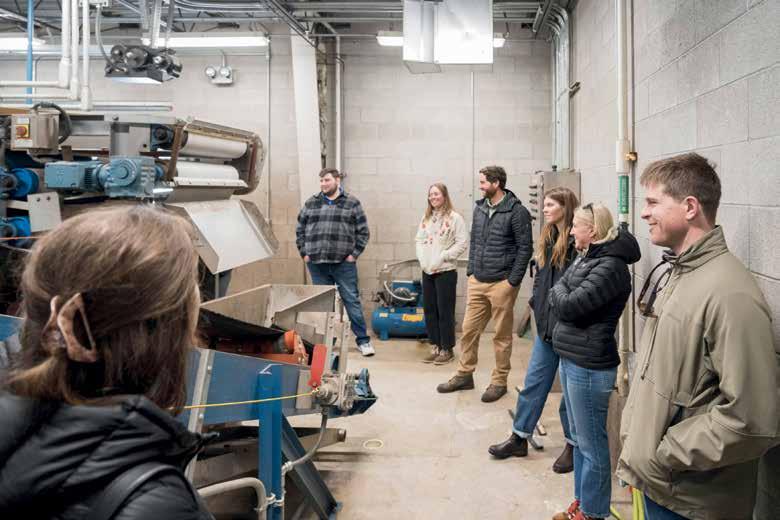
Wednesday, October 2, 2024
Wednesday, November 6, 2024
Wednesday, December 4, 2024
Wednesday, January 8, 2025
Wednesday, February 5, 2025
Wednesday, March 5, 2025
Wednesday, April 2, 2025
Wednesday, May 7, 2025
